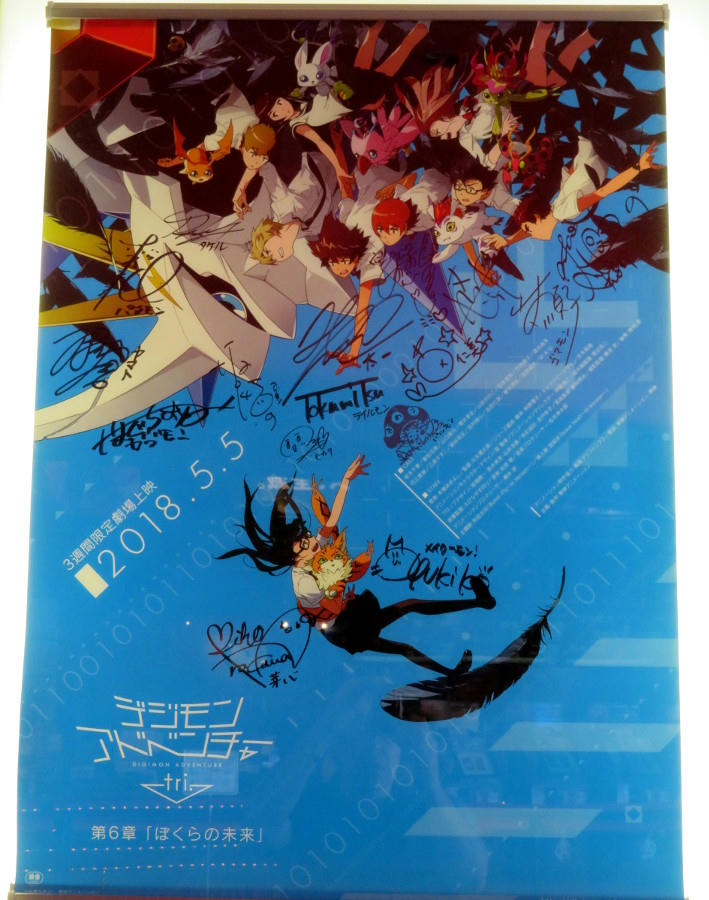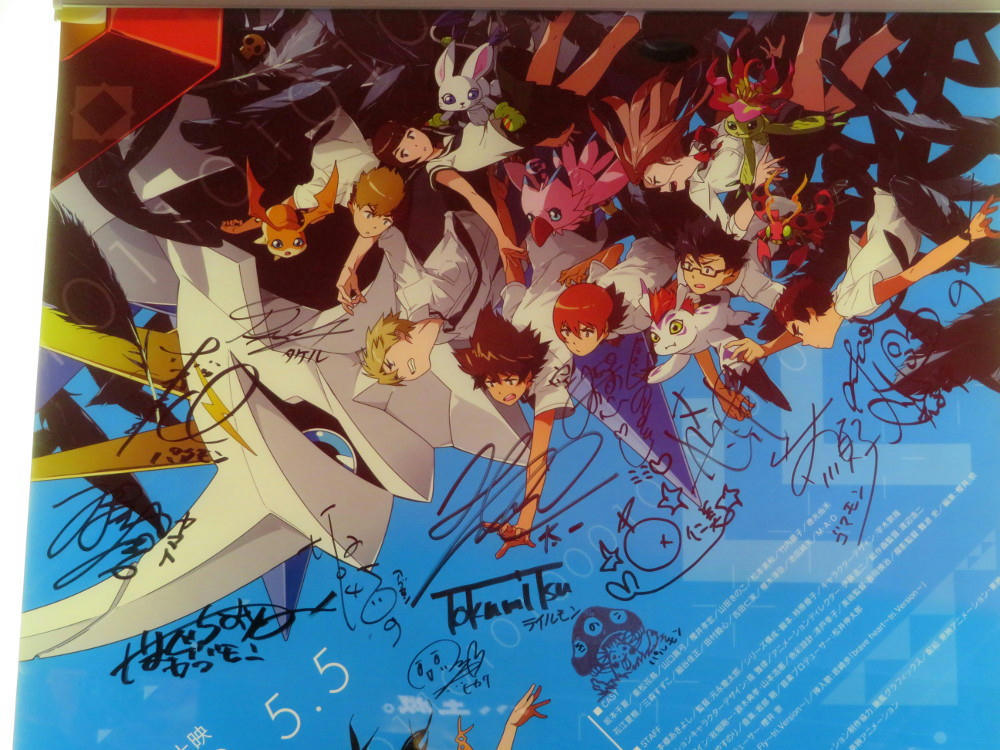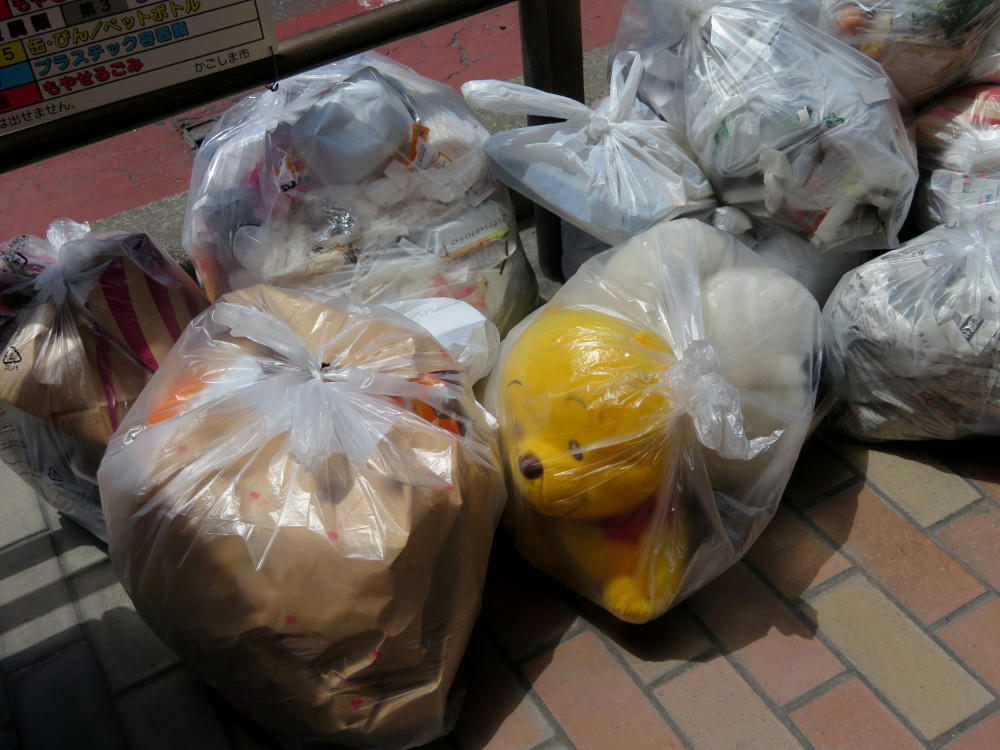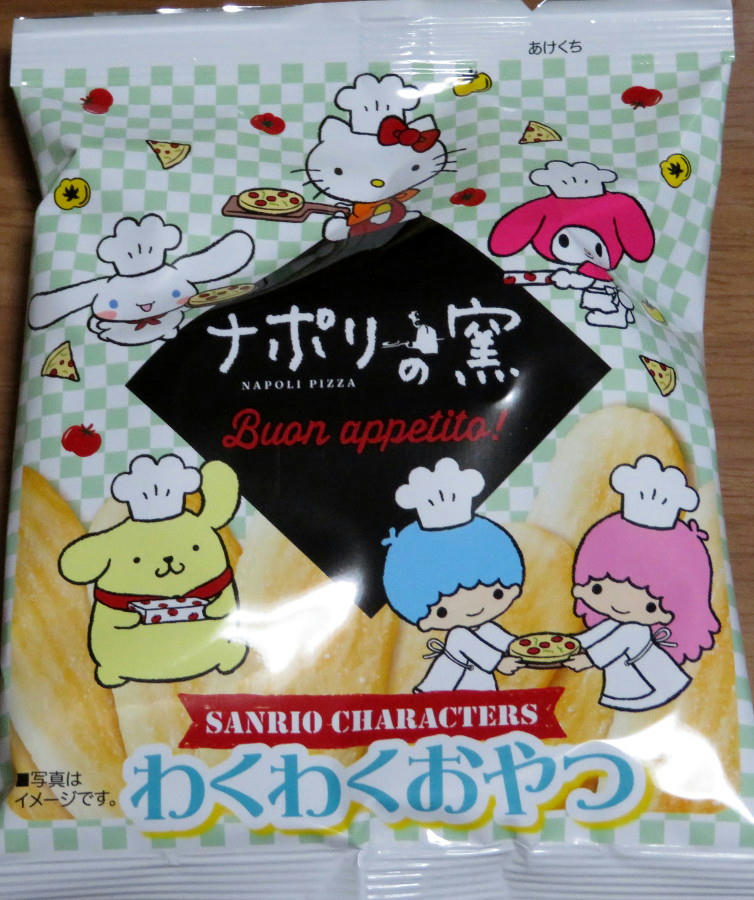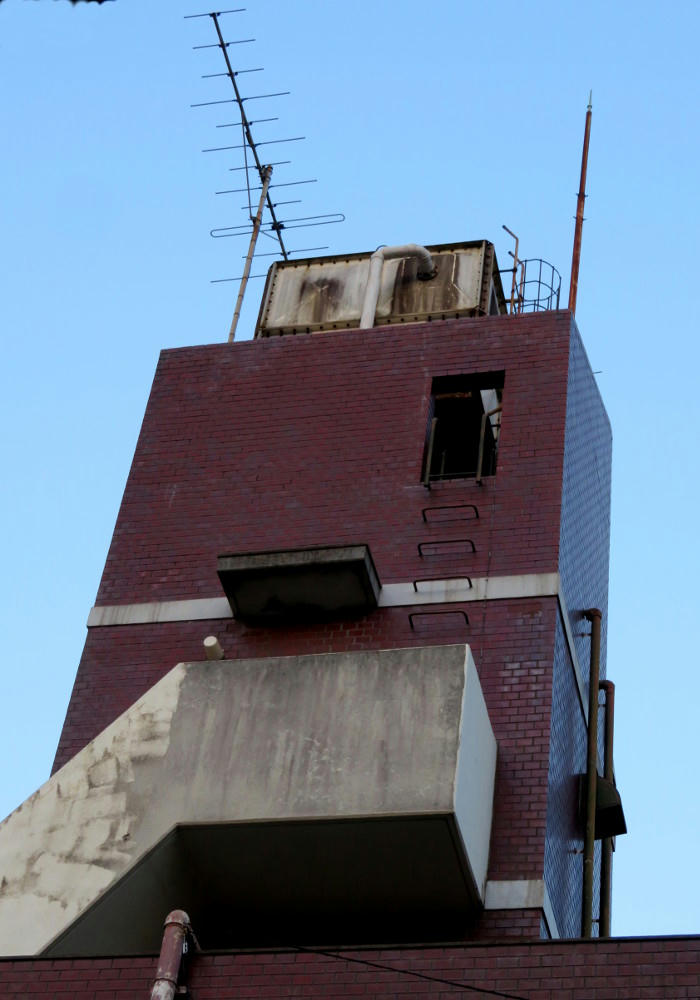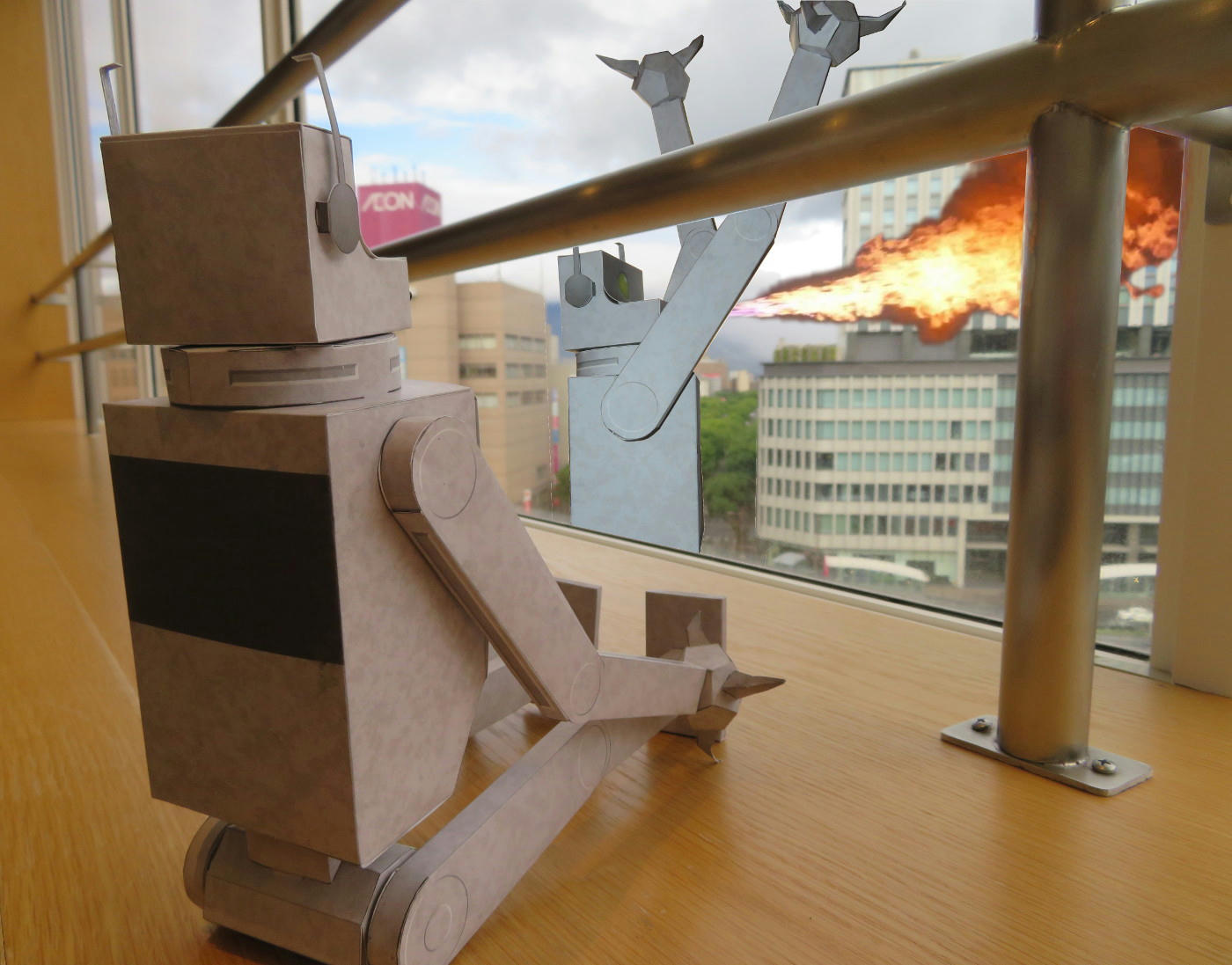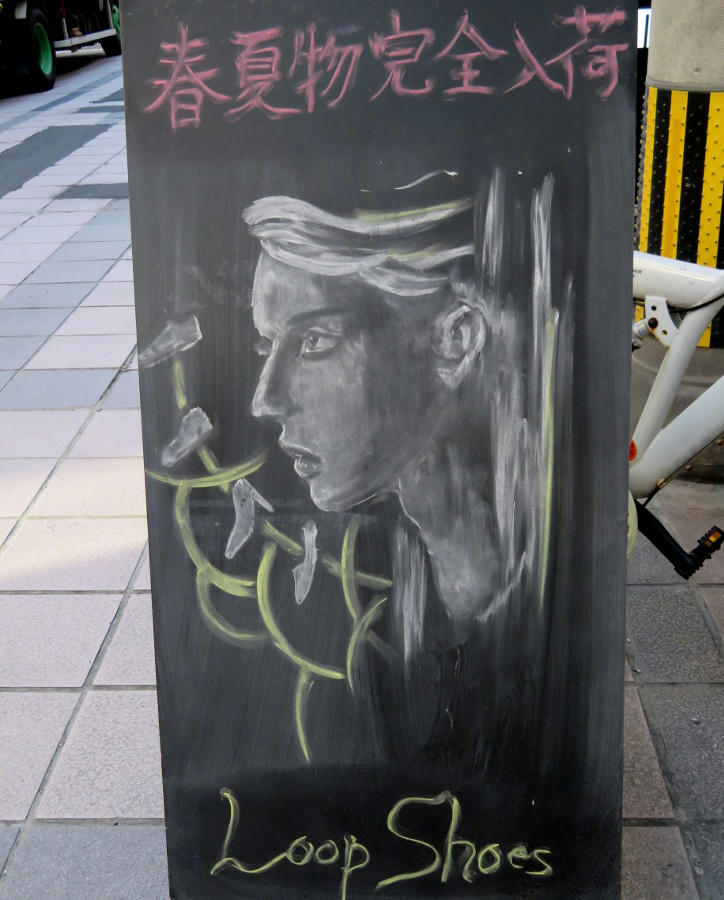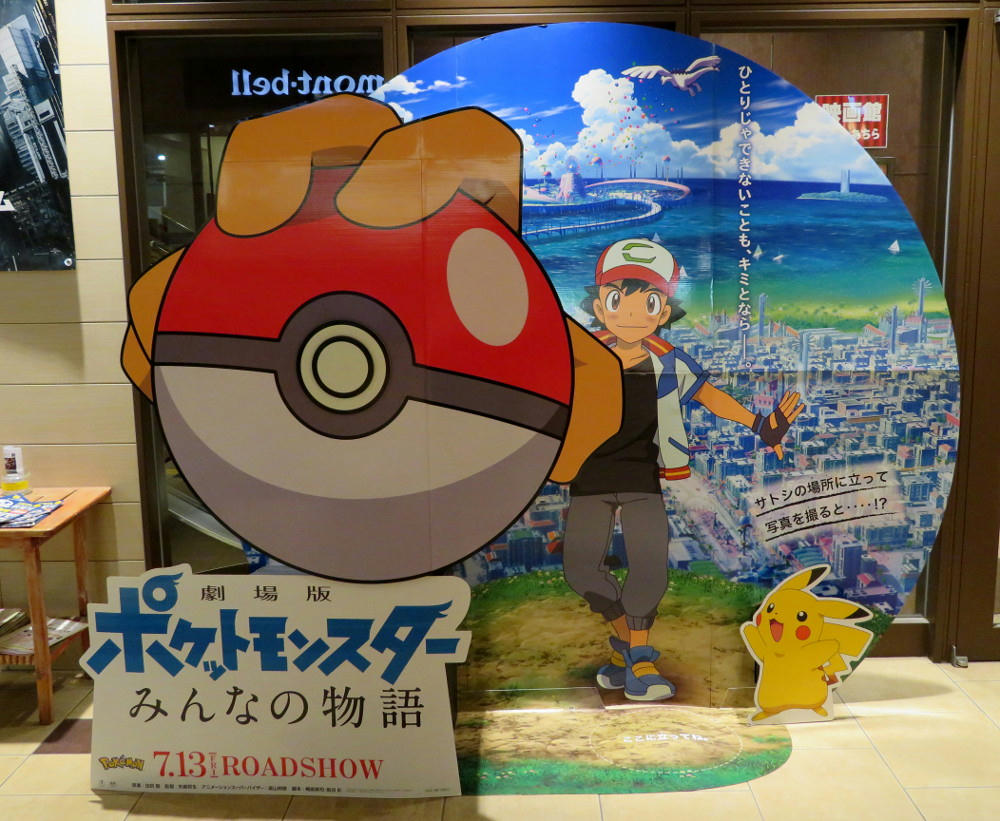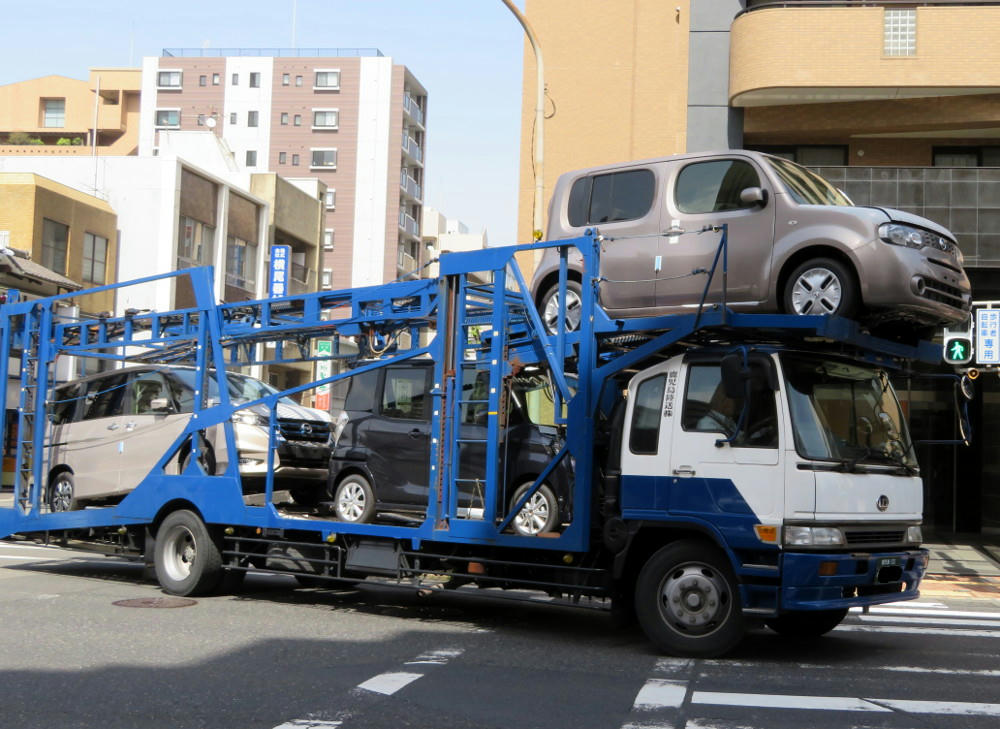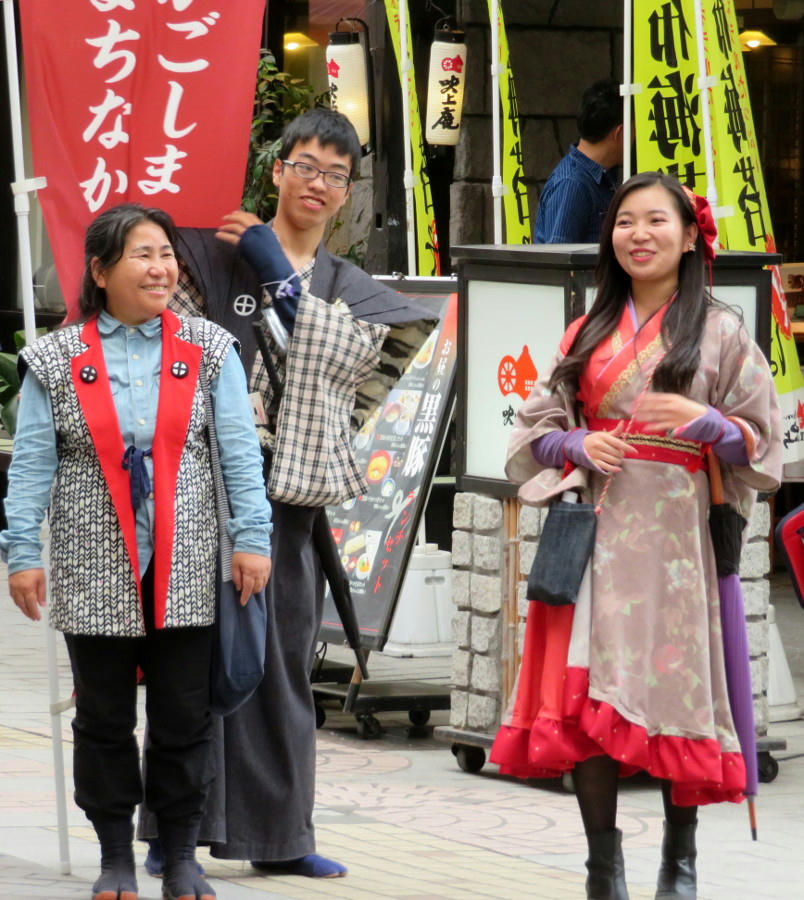Here's the batch of articles to show up in the media from Apr.-June, regarding anime, manga and related stuff.
Japan Times
Studio Ghibli plans to open new theme park near Nagoya by 2022
Dragon Quest VR arcade to open in Shinjuku
Astro Boy manga sketches fetch record price at Paris auction
Will digital piracy ruin the future of manga?
Anime adaptation of 'Young Again in Another World' canceled after offensive tweets by author Mine
'Dokaben' baseball manga series concludes after 46-year run
Daily Yomiuri
Ghibli Park eyed to open in fiscal 2022
Get a kick out of new Captain Tsubasa statue
Innovation underlies success of ‘Pop Team Epic’
Son of baseball legend playing the lead in baseball anime
New ‘GeGeGe no KITARO’ deals with diversity
‘Astro Boy’ sketch fetches 269,400 euros at Paris auction
Boys Over Flowers Season 2 review
‘Beastars’ sees humanity through animal eyes
Rikiishi’s distinctive eyes live on in ‘Megalo Box’
Usogui (Lie eater) review
Metamorphose no Engawa review
Tokiwa-so restoration plan to honor manga culture
Studio Ponoc scopes out short films
‘Hiso Maso’ brings together 2 hot talents
Manga for new audiences / Finding the right voice to create perfect dialogue
‘Patalliro!’ is a curious comedy legend in shojo manga
Asahi
'Yuri!!! on Ice' exhibition brings protagonist to his 'hometown'
'Banana Fish' TV anime series key cast members announced
Everyone’s Story’ revealed as title of new Pokemon movie
First live-action film for 'Touken Ranbu Online' to premiere in 2019
‘Kabaneri of the Iron Fortress’ film coming this year to cinemas
Top writer opens manga academy to nurture talent in his hometown
‘Psycho-Pass’ film trilogy to hit the big screen from early 2019
‘High Score Girl’ TV anime finally is green-lit for July premiere
Evangelion fans get final ride on anime-based Shinkansen train
Hosoda’s ‘Mirai of the Future’ showcased in Cannes’ program
‘Karakuri Circus’ adventure manga set for TV anime series
‘Treasure Island’ on pace to set Doraemon film series record
'Dragon Ball Super' movie to pick up where TV show left off
200 works from ‘Hokusai Manga’ on display at Urawa museum
'Kingdom' history manga gets live-action film adaptation
USJ to offer ‘One Piece’-themed attractions this summer again
Hosoda’s ‘Mirai’, Kosaka’s ‘Okko’s Inn’ compete at Annecy festival
Studio Ponoc unveils short film showcase to begin in August
Star-studded cast for TV drama of ‘Galaxy Express 999’
‘Mobile Suit Gundam NT’ to hit cinemas in November
‘Evangelion Exhibition’ on show at Shimane Art Museum
‘Mobile Suit Gundam NT’ to hit cinemas in November
‘Golden Kamuy’ author doing his homework in depicting Ainu
‘Corner of the World’ gets first live-action TV drama series
7th KYOMAF festival on manga, anime set for Sept. 15-16
Saturday, June 30, 2018
Friday, June 29, 2018
Mugen Shishi, vol. 1 comments
(Image from amazon.co.jp, used for review purposes only.)
Mugen Shishi (Fantasy Gentleman) by Yousuke Takahashi, Grade A
Somewhere about 3 weeks ago, I wrote up a commentary on volume 1 of Yousuke Takahashi's school horror series, Gakkou Kaidan. At the time, I said that I'd first encountered him when I found a used copy of Mugen Shishi, vol. 1, at Mandarake in Akihabara around 2010, and that Shishi is a light-hearted detective adventure set in the Showa Era (1926-1989), in kind of a Doc Savage vein, but still heavily laced with the macabre.
Maruzen Bookstore has wide edition volumes of both Kaidan and Mugen, and after reading the first title, I decided to get the wide version of Mugen. The wides are shorter and narrower than regular tankoubon volumes, but have at least twice as many pages. Vol. 1 of Mugen is a whopping 398 pages, but it's also close to $10 USD, including tax, so it's not exactly a bargain, price-wise. The thing is, because I'd already read vol. 1 of the tankoubon, I knew that the first half of the wide volume was going to be duplicated. On the otherhand, my Japanese is getting better and I was hoping that I might pick up more of the story the second time around.
As mentioned above, Mugen Shishi is a light-hearted adventure series that revolves around boy detective Mamiya Mugen, set in the early 40's. The chapters can be between 20 and 50 pages long, and are generally stand-alone stories, but there are a number of recurring characters, and there is a sense of past adventures building up and influencing later ones, even though there's no true on-going story thread linking them together. In the first chapter, we're introduced to Mugen, police detective Edogawa (which may be a tribute to Japanese mystery writer Edogawa Rampo, which in turn is the katakana reading of Edgar Allan Poe), and the incompetently evil Doctor Lao. Later, we get Mugen's faithful man-bat servant Alucard, his flighty but understanding mother Yuki-e, and his mad scientist father. Additionally, we get mermaids, time-traveling wells, submarines hidden under Tokyo city, Indian curses, giant grasshoppers, killer girl robots and love-struck assassins. One additional theme is that Mugen's father used to dress him up as a girl when he was very young, and he still ridicules his son for being so good at female disguises. Having his mother call him "Mami" (a girl's name) doesn't help. But, Mamiya is very convincing as a Chinese restaurant waitress, even when he has his full suit and wide-brim hat on underneath the China dress. So, yeah, it's complicated.
The last chapter is a reprint of the illustrated text-based short story that ran in the first tankoubon volume - "Neji Otoko" ("neji" = "screw" or "bolt", but in this case it refers to the fact that the villain is a windup machine version of Frankenstein's monster). The literal translation would be "Bolt Man", but that's not really very evocative. "The Wind-up Man" or "The Tick-tock Man" might be better. Anyway, the story is a very silly recounting of when Mugen went up against a mechanical monster whose main crime is that it turns its human victims into windup minions. The final battle is played for laughed, although the monster is destroyed in the end.
Anyway, Mugen Shishi ("mugen = dream" and "shishi" can be treated as "gentry+man", or "gentleman") is a lot of fun and it doesn't take itself seriously. It's not all that easy to find, unless you order it off Amazon, and you probably won't be able to get it in English. But, if you understand a little Japanese, it's definitely a good way to improve your reading skills. Otherwise, the artwork is still great (airy lines, lots of detail; very good character designs in a retro-60's style, and fantastic monsters and backgrounds). Highly recommended.
Thursday, June 28, 2018
Wednesday, June 27, 2018
Tuesday, June 26, 2018
Monday, June 25, 2018
Perfect Star, 2018
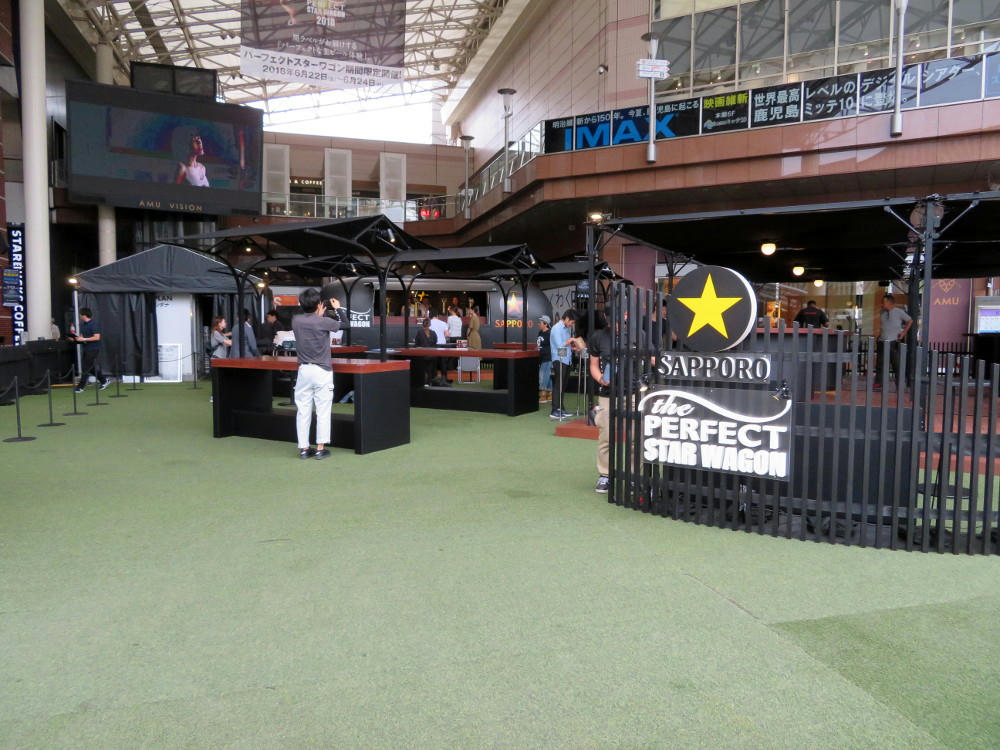
I had to go up to Amu Plaza last Thursday night to get some printer ink from Bic Camera, and I swung by the plaza in front of the train station to see what they had going on. Construction crews were in the process of building a beer garden for Sapporo Brewing, to promote their black label beer. The dispenser truck in the background was billed as The Perfect Star Wagon.
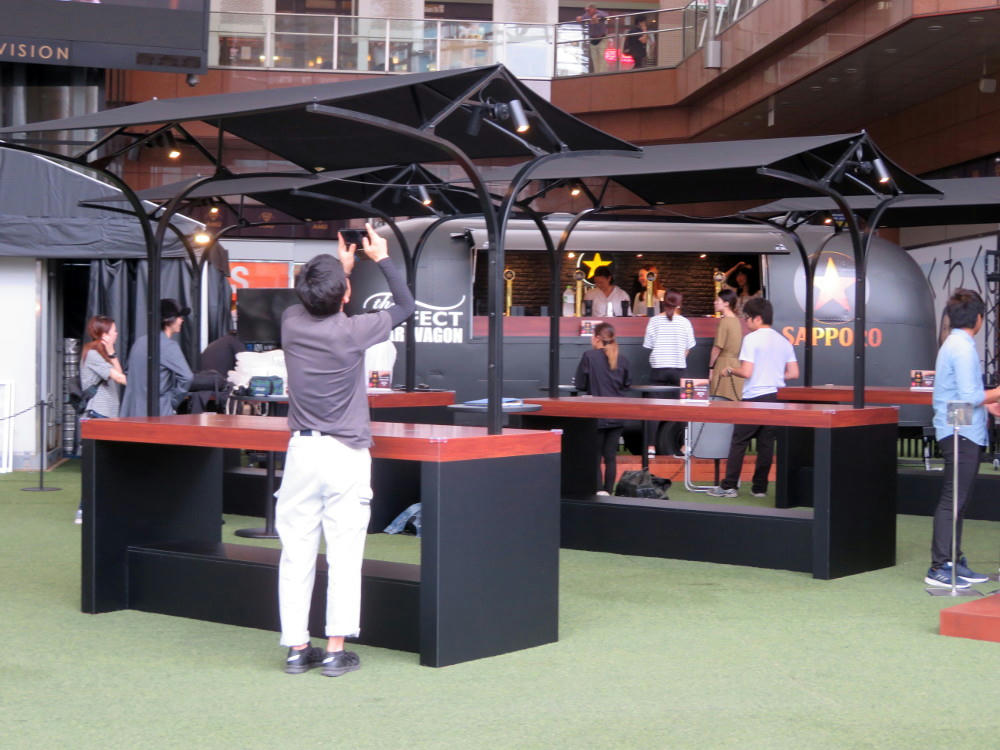
The workers were putting in a lot of attention to what they were doing. Even the guy putting the tables together was giving them a spit polish.
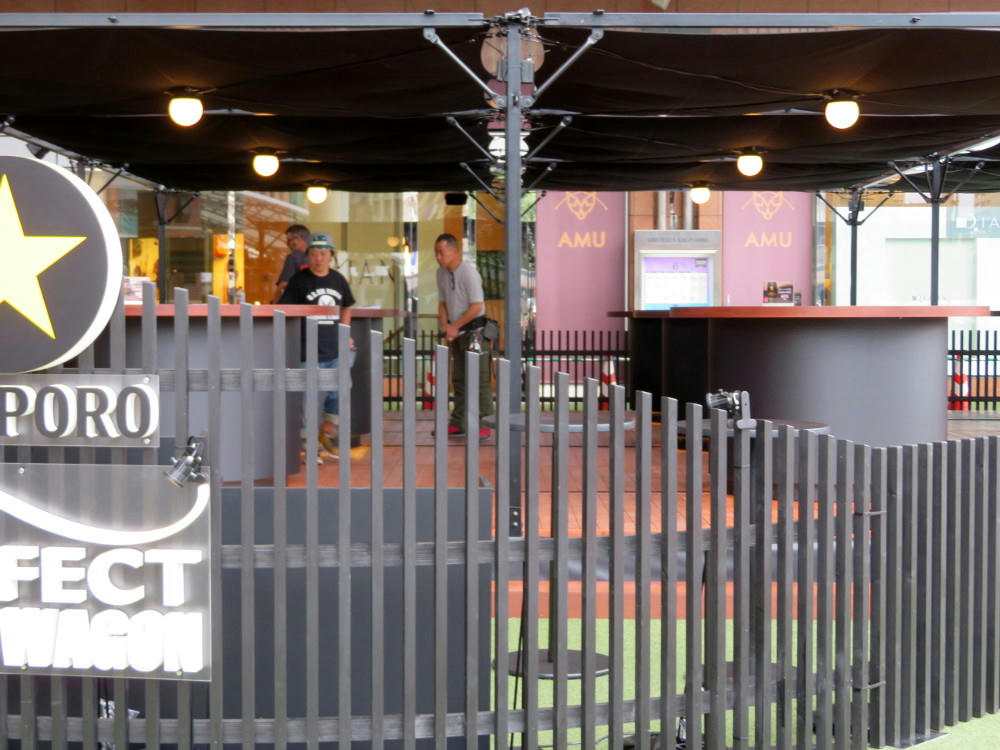
One of the so-called "selling points" for the beer garden was that it's "tachi-nomi", (stand and drink). Apparently, the Japanese have come to believe that standing, and talking and drinking is more friendly than just sitting and drinking.

The garden was open until 10 PM Friday night (9 PM for Saturday and 8 PM for Sunday), so I came back after dinner on Friday.
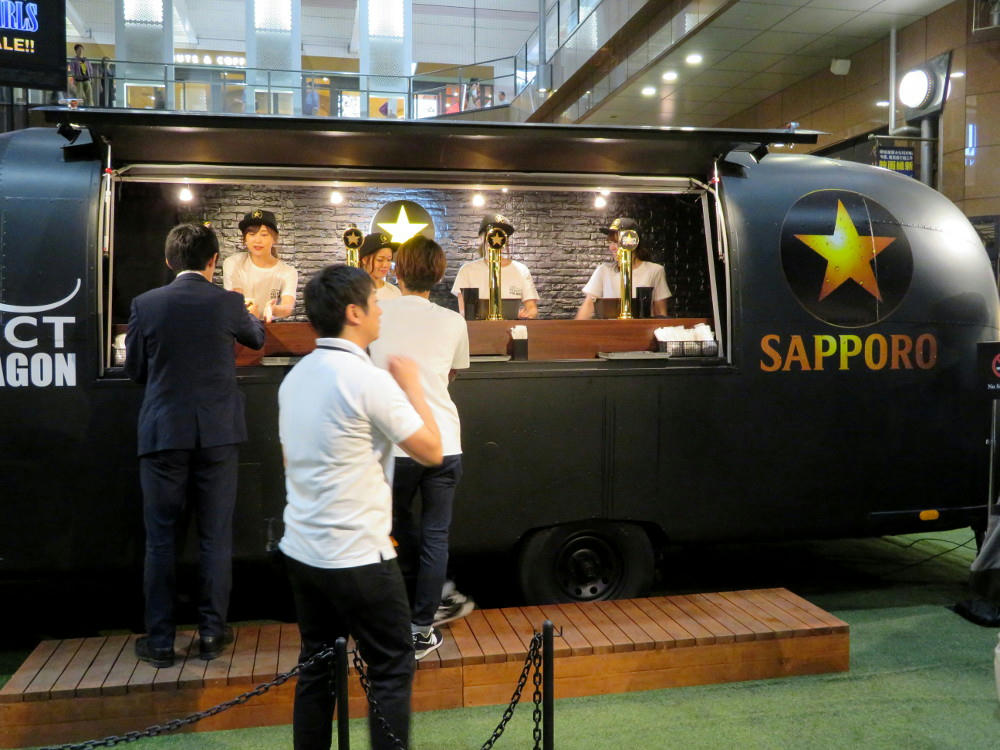
A table near the entrance sold tickets for 300 yen apiece (approx. $2.80 USD) for one cup of beer and a small bag of mixed nuts. The taps were labeled Sapporo Beer Black Label, and Sapporo Beer Black Label (Black). When I presented my ticket, the server took it and immediately went to a different tap hidden in the nose of the truck to the right, so I have no idea if I was given Black Label, or Black Label (Black).
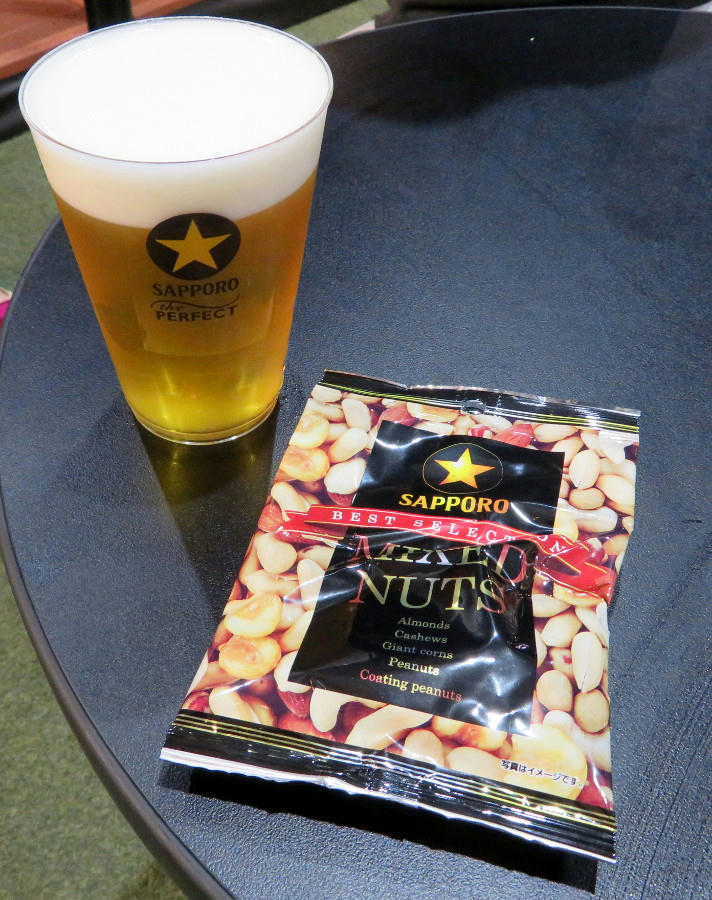
The beer was very smooth and foamy, but the flavor didn't really stand out for me. It was like a lager minus the hops. The mixed nuts were mostly corn nuts, with a few cashews and peanuts added. Nothing really exciting, but not all that disappointing. Overall, an uneventful weekend. Rain alternating with hot and humid spells. Not a great time to be outside.
Sunday, June 24, 2018
Sute Show 2018
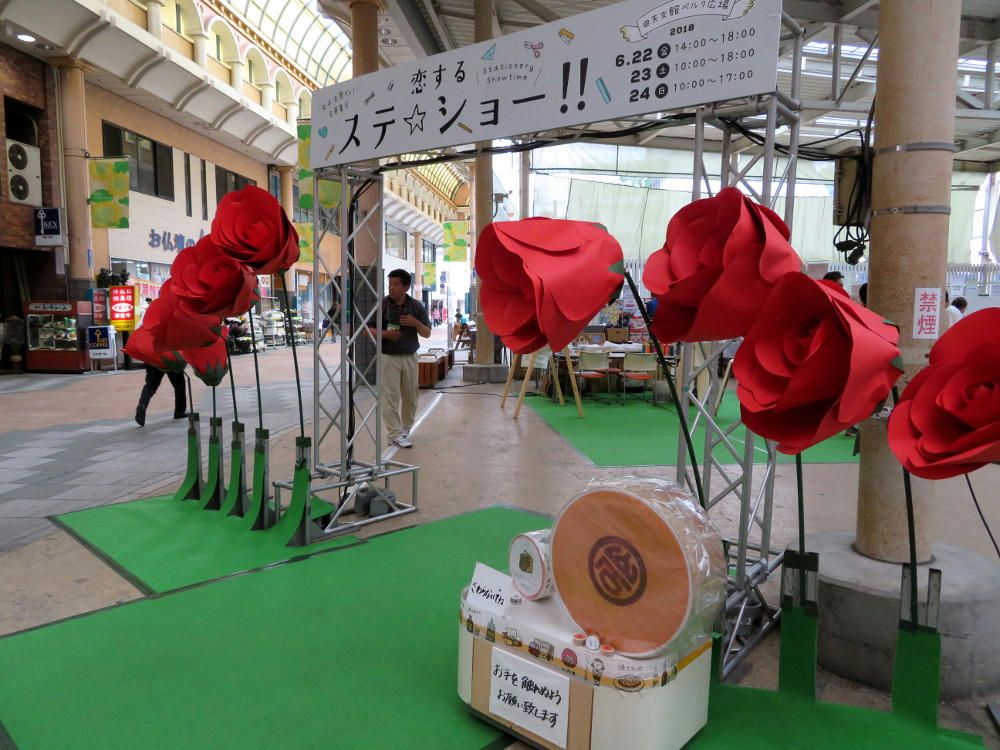
Sometimes we get the oddest sales events in the open space in front of the Lotteria burger shop (the Yamakataya department store is nearby, too, which may count for something). Anyway, over the weekend we had the "Stationery Show," which just consisted of people trying to sell office and craft supplies. The only real reason I took photos was that I was impressed by the papercraft of a large roll of strapping tape at the entrance.
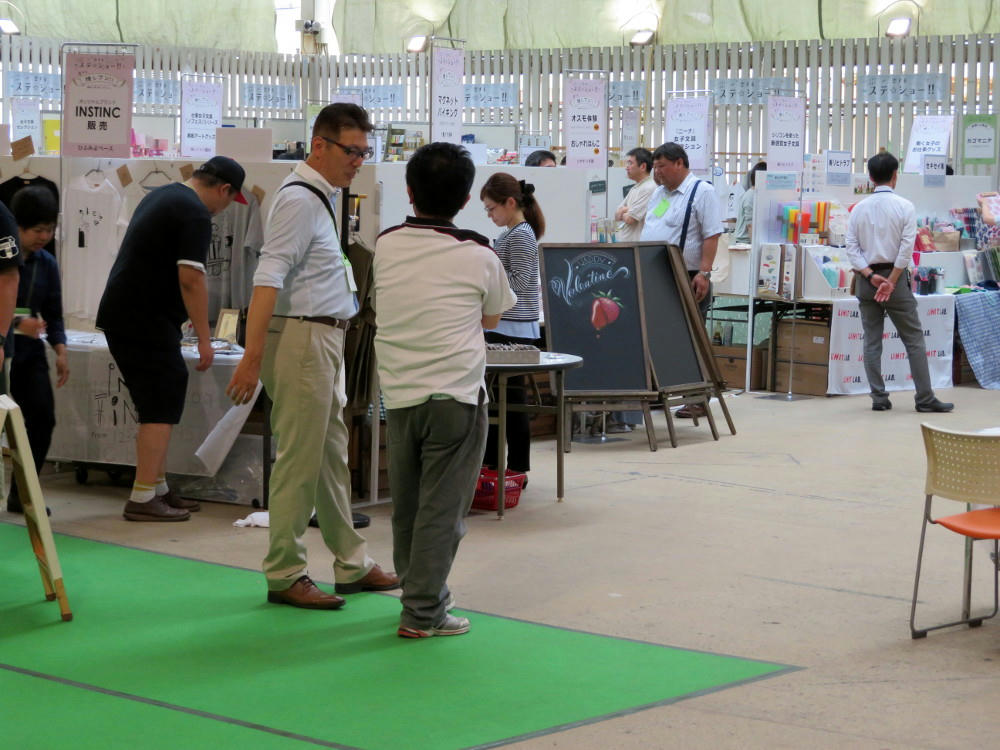
In with all the sales tables, they also had a local history lesson/game show for the children on Saturday. Unfortunately, I was passing by on my way to work and didn't have time to take pictures of that. I assume there were other educational events using the stationery supplies, too.
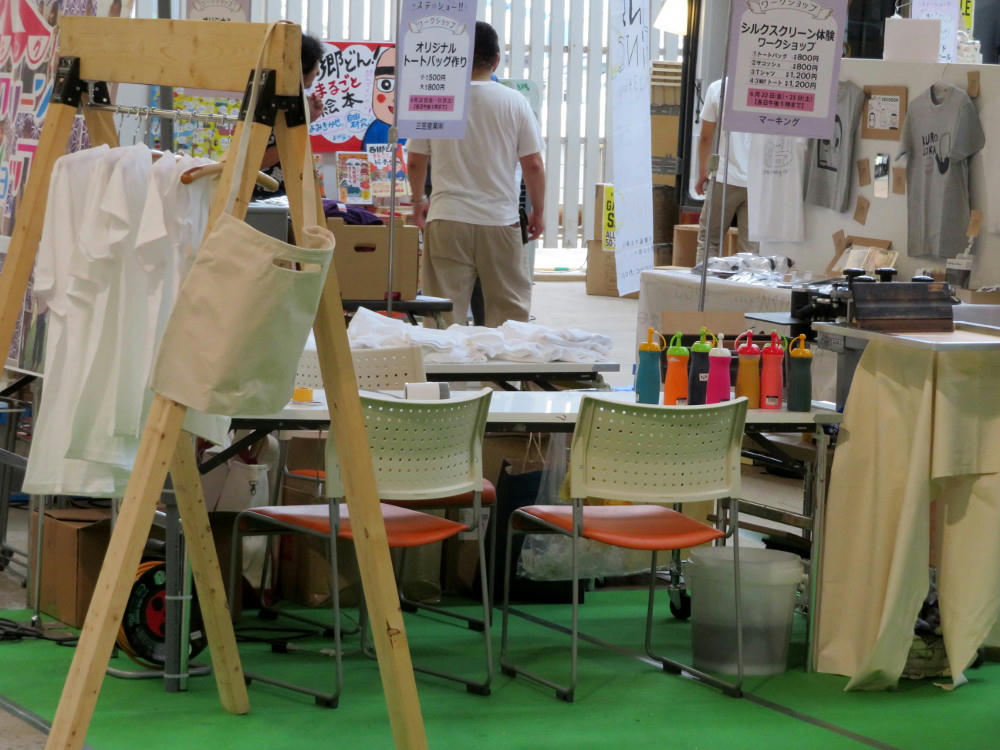
The table above offers silk screening rigs and inks.
Saturday, June 23, 2018
Q.E.D. iff volume 10 review
(All rights belong to their owners. Image from Amazon.com used here for review purposes only.)
Q.E.D. iff, vol. 10, by Katou Motohiro. Grade: B
Two stories this time, and a little bit of topological theory.
Outoro-zu (Outlaws, Magajin R, #2, 2018)
Touma has been requested by stock market trading genius Rich Parman to participate in a gambling game that Parman is organizing on the floating casino ship King Midas (currently near Florida in the Gulf of Mexico. Parman is dying, and he's concerned about the life trajectory of his only daughter, Kate. Kate has become a card sharp, and Parman wants Touma to beat her at her own game to teach her a lesson before it's too late. So, Touma and Kana board the ship for the Outlaws Show, which is the headline entertainment for all the artists, musicians and actors watching on from the dining tables and various locations around this luxury cruise liner. The Outlaws Show consists of 6 groups of players - the husband and wife team, MacGuffin; bag lady Emmett; street hustler Mose, thug Ryuu; Kate; and partners Touma and Kana. Each group is known for their skills in breaking the law. They are each given a key, and three hours to take the keys of everyone else. If there is a clear winner, the person with all the keys gets to open a safe containing a jewel-covered dagger worth millions of dollars. There's a key check every hour - anyone without a key gets ejected from the ship. If, after the time is up, there's no clear winner, the one with the most keys wins. If there's a tie, then no one wins. Several of the participants ask questions - how many people can be in one team; are the rooms off-limits; etc. The main points are that anyone can be on one team, the rooms are monitored from a control room and can be remotely locked if intruders try to break in, and the security guards are unarmed.
The game starts, and the other players run off to start their machinations, while Touma simply lounges on a deck chair. Things get a bit complicated in the first hour, with Kate 3D-printing a copy of her key, Ryuu coordinating a bunch of guys in ship crew uniforms, the MacGuffins studying floor plans, and Emmett sitting in front of a dressing table with a make-up kit and a photo of Kana. Mose hangs at the bar and is surrounded by a bunch of spectators. When he continues on his way, he's shown to be a pickpocket, and had lifted watches and jewelry from his marks. At the end of the first hour, it's Mose that's missing his key and is kicked off the ship (after being told to return everything he stole). Touma admits having been wrong - he'd thought that Mose would have stolen the MacGuffin's key first. Kana asks if he knows who bested Mose, and he says "probably." Kana wants to know how he came to that conclusion, and he responds by going into a brief description of the fixed point theorem (the idea in topology that if you move a group of points around on a surface, there's at least one point that stays fixed in position), and then goes into chaos theory and the butterfly effect. (One example of a fixed point is if you graph the line y=x against the curve y=cos(x), the fixed point is where they intersect at x=cos(x). That is, cos(0.739) = 0.739.) In other words, he's looking at what each of the outlaws considers to be a bad thing or not (armed guards, safe rooms), to extrapolate their strengths, which then lets him predict how they're going to try to get the remaining keys.
In the second hour, Emmett impersonates Kana to try to get to Touma's key (this fails because their key is hidden in Kana's hair), and Kate impersonates one of the crew members to infiltrate Ryuu's team to walk off with their key. Ryuu, meanwhile, has flash-bangs planted around the ship, and uses these as a distraction to attack the ballroom and hijack the safe. But, the lights and electricity suddenly go out, and the ballroom is filled with tear gas. This is the moment Touma has been waiting for, and he races to Emmett's room with his laptop while Kana is to run elsewhere. When the lights and power come back up, the safe is discovered to be open, but inside is a second safe with 6 key locks. Ryuu had thought that by bluffing about having bombs on the ship, he'd be able to force the show MC into opening the safe and handing over the dagger. He's left in a state of shock at learning that the winner needs all six keys, and then the second hour is up.
The remaining five teams are told to produce their keys, and the MacGuffins, Ryuu and Emmett all snarl that they'd been taken somehow. Kate shows that she has two keys, and Kana pulls four out of her hair. Everyone demands to know how this has happened, and the audience is going wild with their online bets for who the final winner is going to be. Touma goes into the first of two Q.E.D. explanations (the splash panel shows "Q.E.D", with the last period missing.
Questions: How did the losers lose their keys? Will Touma win and show Kate the error of her ways? Or, is something else at play here? Is "Rich Parman" just a silly name, or does it have a deeper meaning somehow?
Science: The Fixed Point and Chaos Theory expositions.
----- Spoiler 1 -----
Emmett is a young woman who is a master of disguise. She had originally wanted to pose as Kana, but the girl never left Touma's side, so she switched over to a normal-looking woman and hung out next to Mose, stealing his key while the thief was picking the other guests. She then dressed like Mrs. MacGuffin, and tricked the husband into giving her that key. As mentioned above, Ryuu's team pretended to be members of the crew in order to pull a guerrilla attack on the ship and commandeer the safe, only to have Kate dress up in a crew member's uniform and walk off with the suitcase Ryuu had locked his key inside (having swapped that key out with her 3D-printed copy). Emmett, thinking her room was safe, had left her three keys on the table near her bed, so when the lights and power died, Touma used his laptop to hack her door lock and walk off with them. On top of this, the MacGuffins are professional safe crackers, and they're the ones that had knocked out the power and air conditioning, and used tear gas to clear the room, only to realize that they hadn't allowed themselves enough time to tackle the second safe. This leaves Touma ahead with four keys and Kate with two. The audience yells for Touma to simply bide his time, wait out the clock and win by default. But, card sharp Kate challenges him to a hand of poker - winner take all. And, if Touma wins, he gets an extra $30,000,000 out of her own pocket. Touma takes the bet.
Soon after, all the guests are kicked out of the ballroom, and have to content themselves with watching the poker match on closed circuit TV. However, there are table top cameras so they can see the players' hands. Touma's first cards are a pair of threes, and Kate has an Ace and a bunch of garbage. Kate takes 4 cards, and Touma asks for 3. Kate gets 2 pair, Aces and twos, while Touma has three 3's. But, when they lay their hands down, Kate reveals a full house - two Aces and three 2's, and Touma has four 3's.
Questions: How did Touma win the poker hand?
----- Spoiler #2 -----
The MC, and dealer, takes off his disguise to show that he's actually been Rich Parman all along. Kate rushes to his side, apologizes for being a bad daughter, and demands that her ailing father sit down, rest and stop pushing himself to the brink of death. Touma is allowed to walk off with all the winnings, but he says that he won't take the dagger or the money. That's not why he agreed to enter the Outlaws game. He goes down the outer ladder of the ship to take a speed boat to shore.
Questions: Why is Touma turning down the money? Why is he really there? Why is the makeup of the audience so important?
----- Spoiler #3 -----
All along, the audience, made up of wealthy athletes, musicians and actors, has been using their smartphones and tablets to place bets with the onboard gambling system. In fact, everything about this ship and the Outlaws Game has been a scam to allow Rich and his daughter to infect the phones and tablets with virus software for gutting everyone's bank accounts and credit cards. Kana's task when the lights went out was to sneak into the control room and get proof from the computers there of the virus. As Kana and Touma leave on the speedboat, a submarine pops out of the Gulf, accompanied by power boats filled with cops to arrest the bad guys. At the end, Kana asks how well Emmett had impersonated her, and he repeats that she doesn't want to know (Emmett had actually tried to seduce Touma as Kana).
Daiingumesseji (Dying Message, Magajin R, #3, 2018)
There's a resort hotel on a small island south of the main Japan chain that has a ghost hotel near a beautiful sandy beach. One day, while Touma is vacationing on the island (he takes an annual break in the village nearby to read all the books that he'd been stockpiling for the year, and refuses to do anything else until he finishes them), some demolition crew members prepping to blow down the hotel drill into a pillar and discover the white bones of a corpse hidden in the cement. There's no real police force on the island, only a small detective agency, and the villagers try to get Touma to help them solve the crime, but the boy says no, not during his vacation. This forces Kana to do all the footwork to find out what's going on. Meanwhile, the detective, Tokuji Nakanosato, is hired by one of the people involved with the abandoned hotel, and he tasks his assistant, the young woman Rika Hachijou, to talk to the "police rep" on the island (which turns out to be Kana, the daughter of the Tokyo Police Superintendent). Rika and Kana then strive to figure out what's going on.
The cast consists of Kimiai Ooga, the real estate manager trying to sell the old hotel; Miwako Kashidate, a land developer; Chiaki Mihara, a labor lawyer; Bunji Sueyoshi, a former General Affairs Office director; Mei Yuhama, the construction head for the hotel project 30 years ago; Ryouzou Karataki, a prefectural assembly diet member; and, Tomoko Oosaka, a tax counselor. Basically, 30 years earlier, Mei ran the construction project to create a luxury hotel facing the beach front of this island. There were labor disputes, and reports of unsafe working conditions, and Chiaki was brought in to represent the workers legally against the construction company. For the most part, things were going ok, and a big ribbon cutting ceremony was scheduled. Chiaki disappeared about that time, and Mei was never seen again after the ceremony. With Mei gone, the hotel was abandoned and the project went nowhere. Kana says that based on the evidence, the corpse in the pillar is that of Chiaki, and the belief is that Mei killed her before running away to avoid exposure. However, the pillars had been poured long before the ceremony, so there's no explanation for how the body could have gotten there after the fact.
In the present, the other characters all act suspicious in one way or another. Kimiai is the real estate agent trying to unload the property, and looks to be at his wit's end. Miwako is a brash middle-aged woman that always wears dark sunglasses, and a scarf over her hair, and walks with brace crutch on her right arm. She's the one offering to buy the property, but only if the price is cut in half. Ryouzou had possibly taken bribes under the table when this obviously unwanted hotel was being built during the economic bubble. And, Bunji may be complicit. Finally, Tomoko claims she can't remember anything about what happened so long ago. Rika points out that her accounting records for that project from that period are all wonky, and Tomoko insists, with the steady gaze of the insane, that all the numbers must have been correct at the time, someone must have messed with them since then.
After interviewing everyone and getting nowhere, Rika suddenly calls Kana to report that her boss, detective Tokuji, is in the hospital with a head injury. Tokuji had looked at the case files, then called all the suspects out to the hotel to meet him at 11 AM that morning. Around noon, Rika had gotten a call from the authorities saying that her boss had been injured. She got to the hotel as Tokuji was being loaded into the ambulance. She saw the suspects nearby, and Ooga explained what had happened. He'd gotten to the hotel 30 minutes ahead of time, and as he'd walked into the lobby, he met Miwako, who was approaching from the back end of the first floor. She complained that the place was a mess and he should drop the price more. Ryouzou was coming down the stairs from the second floor, and Bunji entered from the outside rear door, claiming to have been walking in the overgrown garden path outside and gotten lost. Last to arrive was Tomoko, through the front lobby doors. They waited together, and when Tokuji failed to appear at the appointed time, Ooga called his phone, and the group heard it ring from up on the third floor. They went up, and identified the room the sound was coming from. But, the door was found to be blocked from the inside by a small refrigerator, and Tokuji was in the room, lying unconscious on a rotted mattress. The guest room was small, empty except for the mattress, and with one small window boarded up from the inside. It's a locked room mystery. Tokuji remains unconscious for the rest of the story.
Rika is frustrated that her boss has left her in this position, and as she's ranting, she throws herself into Tokuji's chair. She spots the case file, which includes Chiaki's photo, taken some time shortly before she disappeared. She's wearing the same clothes that the corpse was found wearing. This proves that Chiaki was the victim, and the most suspicious person she knows of is Bunji, who had entered the hotel from the back side. The room Tokuji was found in was also at the back side of the building. Obviously, Bunji had encountered Tokuji early in the morning, conked him on the head, carried him to the guest room and put him on the bed, slid the refrigerator in front of the door, then used a length of wood to prop up a corner of the sheet nailed to the window so he could slip through, then let the sheet snap back into place before lowering himself to the ground with a rope hanging from the railing up on the roof. Rika tells her deductions to Touma. The boy has just finished the last of his book reading, and he says "well, that's certainly a possibility, too." However, when Touma, Kana and Rika eventually do meet the culprit at the hotel, we get a first-person view from the culprit, with no hints as to who it is, and Touma's doing all the talking.
Questions: Is the corpse that of the rights lawyer Chiaki, or not. Why would Bunji kill her? How did Tokuji get locked in the guest room, and why didn't Bunji just kill him outright?
Science: None.
----- Spoilers -----
Touma's explanation starts with the floor layout. Originally, the plans did not include the three central pillars in the middle of the lobby, and their positioning now doesn't line up with the other pillars making up the lobby walls. What had happened is that when the lobby was being built, the construction head, Mei, had wanted the lobby open and spacious. But, the building inspector had come in and complained to Ryouzou that the floor above the lobby wasn't rated for the building's weight. Ryouzou yelled about this to Mei, and she decided to pull the decorative sheeting off from the fronts of the existing 6 pillars around the walls, and fitted them together in the middle of the lobby to create three empty shells in the middle of the floor. To all intents and purposes, the lobby now had proper load-bearing pillars, and the inspector signed off on the project. Mei attended the ribbon cutting ceremony, and everything seemed to be fine now.
However, Chiaki had seen the lobby plans in her work with the laborers, and she knew what Mei had done. To keep Chiaki silent, Mei grabbed a crowbar, and attempted to kill the lawyer with it. Unfortunately for Mei, Chiaki was able to defend herself, taking damage to her right arm, and she killed Mei in self-defense. Chiaki then switched suit jackets with Mei, stuffed her into one of the empty pillars, and used one of the nearby cement trucks to fill up all three empty pillar shells. After this, she disappeared to parts unknown to make a new life for herself as a land developer. She'd come back to buy up the hotel before anyone could tear apart the pillars to find the body. When Tokuji got too close, she found a linen closet on the third floor of the hotel, and moved the refrigerator and an old mattress from another room into the closet to make it seem like an abandoned guest room. She led the detective into this room, hit him on the head, placed him on the mattress, then used a rope to lower herself down the clothes chute in the linen closet to the laundry room below. This is where she was coming from when she met Ooga at the lobby. In fact, Chiaki is Miwako Kashidate. She'd been faking a limp and using the brace crutch to hide the huge ugly scar on her right forearm she'd gotten when Mei attacked her with the crowbar. She'd given herself away when she'd described a part of the hotel interior no one should have known about otherwise. Chiako prepares to leave the hotel, because there's no proof of her wrong-doing. She comments to Rika, though, that while people's memories fade after 30 years, the scars don't. And, she's been waiting for 30 long years for this moment to arrive; she's willing to wait a bit longer for her own time to come.
Summary: I found Outlaws to be entertaining and fast-paced, and I was completely unable to tell where the story was going. The ending fooled me, too. Nothing about this was overly probable, but it still fell into the realm of a Hollywood action movie. And, I liked being able to learn about the Fixed Point Theorem. There never really was a dying message in Dying Message. It's a more straight-forward mystery, and I figured that Miwako had the best chance of being the villain based strictly on appearances and behavior, but I couldn't explain why. The locked room mystery wouldn't have worked as described, because there would have been scrape marks as fridge and the mattress were dragged into position, if they hadn't completely crumbled after rusting or rotting in the sea air for 30 years. The mossy floor would have shown shoe marks leading to the clothes chute as well. Etc., etc. Still, it was a fast read. Recommended if you like the series.
Friday, June 22, 2018
C.M.B. volume 38 review
(All rights belong to their owners. Image from Amazon used here for review purposes only.)
C.M.B., vol. 38, by Katou Motohiro. Grade: B
If you're not familiar with the magazine that C.M.B. runs in, it's Monthly Shonen Magajin, a big "phonebook"-style publication. C.M.B. chapters average 50 pages, and the chapters come out monthly. In this volume, we have two stories - the first one is one chapter, and the second takes up the other 3 full chapters. They were originally printed in issues Jan.-Apr., 2018.
Mokugeki Shougen (Eyewitness Testimony, Monthly Shonen Magajin, Jan. 2018)
This is a simple mystery told from the viewpoint of Kyousuke Harumi, a young man accused of attacking his girlfriend, Mami Sumida, with a knife. The chapter starts with Kyousuke facing charges in court, under the glares of Mami and her father, Touji. The young man claims innocence, while the prosecutor asks for a sentence of 7 years, ostensibly because Mami was a promising young pianist and the damage to her left arm from the knife wound has sidelined her career (she's still taking physical therapy to get the ring finger on her left hand to move properly). Two months go by, and the judge sentences the man to 4 years in prison. Time flies, and Kyousuke is released, cursing the loss of that part of his life. As he exits prison, he's met by a weird old guy (who actually looks like Shinra in a bad haircut and fake glasses and bulbous nose). This guy introduces himself as Kouryou Kanda. Kanda invites Kyousuke to a grilled steak restaurant, and tells him that he knows the younger man is innocent. There's a witness, Ugetsu Ishibana, an itinerant worker who had been sleeping on a park bench near the place where Mami and Kyousuke had been standing at the time of the "attack." Ugetsu heard them shouting, and had crawled over to a break in the bushes in time to see Mami slash herself in the arm with a carving knife. Kyousuke crows that this vindicates him, and wants to know where Ugetsu is. Which is the problem - Ugetsu often works on fishing boats, and between jobs he will travel to other cities to pick up more work. If Kyousuke wants to clear his name, Kanda is willing to help him get work through a temp agency to try to track down Ugetsu. Kyousuke is more than eager to take the man up on this offer.
More time goes by. Mami is still trying to play piano, and her left-hand ring finger is still not moving right. A fact not lost on her father. Eventually, Touji Sumida goes to Shinra's natural history museum, and offers the boy a magic lantern projector (the specific model is here). In return, Touji wants Shinra to track down this "Ugetsu" for him. Shinra and Tatsuki locate Kyousuke, who has been on Ugetsu's trail for nearly 3 years. During this entire time, Kyousuke has been just one step behind Ugetsu, but now it looks like he's finally found some other fishermen that have just finished doing a tour on the ocean with Ugestu, and are celebrating with a dinner party at a nearby restaurant. Shinra, Tatsuki and Kyousuke go there to finally get testimony proving that Kyousuke is innocent of attacking Mami.
Questions: Why is Touji so interested in finding Ugetsu before Kyousuke does? Why did Mami cut herself? Why has Kyousuke been so bad at finding Ugetsu up to this point? What is Kyousuke going to do once he gets Ugetsu's testimony? What is Kouryou Kanda's interest in all this?
Natural History: We get a short Japanese folk tale.
Payment: The magic lantern.
----- Spoilers -----
On meeting Kyousuke, Shinra notices the rice cooker that the man uses in his apartment, which had been supplied by the mysterious Kanda. He gets the man to tell his full story. When that's done, the clock in the room reaches midnight, and Kanda runs into the room to say that he's gotten more information on Ugetsu. Kyousuke attacks him because the last lead turned out to be a complete dead end. Shinra then tells a little story titled "Isui no Yume" (One Boil Dream), also known as "Kantan no Makura" (The Tree Cricket Pillow). In the story, a young man meets an old sage while the two are traveling. The two prepare dinner together, and while they wait for the rice to boil, the sage gives the young man a Japanese style headrest (makura) and he lies down to sleep. After waking up, the young man becomes rich, powerful, and surrounded by beautiful women. Years go by. Finally, the young man wakes up again. The rice has yet to finish cooking - it's all been a dream. Shinra asks Kyousuke to think about the rice cooker he'd gotten as part of the apartment furnishings from Kanda. What does Kyousuke's cooker, and a few other clues from the folk story have in common? Answer, they make up the name Kouryou Kanda. Additionally, the name "Ugetsu Ishibana" is made up of the kanji for "a flower growing from a stone" and "a moon visible during the rain". Neither of these things are possible, pointing to the fact that Ugetsu never existed. In fact, Kanda is Mami's father, Touji Sumida, in disguise. Touji had been upset that Kyousuke's sentence had been commuted down from 7 years to 4, and had wanted the guy to serve out the last 3 years as punishment for injuring his daughter. At the end of the chapter, Kyousuke still refuses to accept his guilt for the attack, blaming everyone else but himself. Touji had used Shinra to break the truth to the criminal at midnight of the 3rd year anniversary of Kyousuke's release from prison.
Hikari no Kyojin (Giant of Light, Monthly Shonen Magajin, Feb.-Apr. 2018)
Ok, we're going to need a lot of backfill here. Snorri Sturluson was a historian, poet and politician from Iceland (1179-1241). He's best known for having collected all of the existing folktales into the Prose Edda, in which we get the origins and legends of Odin, Thor, Loki, Midgard and the end of the world with Ragnarok. However, Snorri was also a lawyer, and had been elected lawspeaker of the Althing, the only public office of the Iceland commonwealth. He was invited to Norway by King Hakon 4, who wanted him to convince the people of Iceland to submit themselves to Norway. He returned to Iceland, but the other chiefs there wanted to get him out of their way. A nephew, Sturla, raised an army against Snorri, driving the older man into hiding. Snorri eventually returned to Norway, but Hakon was disappointed in Snorri's inability (or unwillingness) to make Iceland a fiefdom of Norway, and he sent a request to Snorri's relatives to have Snorri assassinated. This eventually did happen in 1241. Snorri's lasting legacy was in collecting the stories that made up the Edda.
The story alternates between the 1200's and the present day. In the past, we have Snorri going to Norway to collect stories for his Edda, accompanied by Olen, a young, weak-willed, recalcitrant assistant who does all the legwork in finding folktales in whatever land they visit, while whining over Snorri's ability to wed beautiful women and marry into some of the most powerful families in northern Europe at the time. Olen keeps reminding Snorri that Hakon is getting increasingly more angry about the old pervert's failure to bring Iceland under Norway's control. Snorri is impervious to these calls of doom, and continues on his merry way. At one point, Olen mentions that there are tales of the Holy Grail being in Norway, and that it can cure all diseases. He comes down with a horrible cold, and is visited by Snorri, who is carrying a plain wooden cup filled with hot water. After drinking the water, Olen falls asleep, and wakes up completely cured. He's convinced that Snorri had found the grail. Eventually, they run afoul of Sturla's assassins, and Hakon 4's ire, and Snorri is forced to hide his treasures in a cave somewhere in Iceland.
In the present, Ryouta Tomonaga, a second grade junior high student, is having a miserable time. His parents have divorced, and he's been forced to live with an uncle. His step-aunt hates having to take care of him and wants him dumped on someone else. He's being bullied by neighborhood toughs, and the only thing he has to hold on to is a pocket knife his father gave him. In the middle of his step-aunt's screaming at his uncle to do something about the boy, Ryouta discovers a package from his father. He opens it to reveal a large calcite crystal, and a note with some weird marking on it and instructions to his uncle to contact Shinra. Ryouta's step-aunt is in full rant, so the boy decides to find Shinra's museum on his own. But, once he gets outside, he is approached by a couple strangers that try to take the crystal from him. These guys are attacked by a different group of foreigners that kidnap the boy and stuff him in the trunk of their car. He uses his pocket knife to get at the trunk release cable and frees himself. He reaches the museum, where Shinra uses the calcite on the strange markings. The crystal's main property is that it causes lines to appear as doubled, so the markings can be read through the crystal as "GRALL." Shinra puts all the clues together to say that Ryouta's father is in Iceland (this particular calcite is called " Iceland spar"), looking for the Holy Grail, and that the boy is being followed by neo-Nazis that want the Grail as one third of the items Hitler sought for world domination (the other two being the Spear of Longinus, and the Imperial Crown of the Holy Roman Empire.
Shinra decides to find Ryouta's father, and the boy insists on tagging along. Tatsuki goes with and the three of them are soon in Reykjavik. Shinra talks a lot about the grail, and how it's currently believed to be in Iceland, in part because of stories involving Snorri Sturluson. As they're standing around near a statue of Snorri, an Icelander approaches them, asking if they're Japanese. He hands them a pamphlet from Ryouta's father, and warns them of suspicious-looking men a block away. Ryouta recognizes one of the men as the neo-Nazi that had tried to kidnap him. In the pamphlet is a GPS coordinate, and instructions to find the "giant of light." Tatsuki uses her smartphone to pinpoint the coordinates about 80 km east of them, but as they make their way out of the city, the enemy spots them and gives chase. Tatsuki ambushes three of their pursuers, stealing their horses, which makes the subsequent trip much easier. They spend the night out on the ice and lava flows, and Ryouta turns into a whining ball of fear (identical to Olen when he was with Snorri), blaming his father for his being so miserable now. But, Tatsuki notices the northern lights surrounding them, and Shinra figures out that the clue in the pamphlet refers to a particular area in the landscape where the lava outcroppings and aurora form the silhouette of a giant made of light.
Eventually, Shinra finds Tomonari's camp (I don't think Ryouta's father is ever given a first name), and the guy wants to know why Shinra brought his son instead of his brother. Ryouta yells at his father for everything that's happened to him, and the guy says, "Yeah, it's quite an adventure, isn't it." Ryouta answers back "You're not out on an adventure, you're just playing around." The Neo-Nazis catch up to the group, and Tomonari has them put on an ice crampon each. They escape over the ice field. Their pursuers have to go more slowly after them because they keep falling through snow-covered cracks. Tomonari gets to a cave in the lava flow and they go down into a tunnel. Tomonari had found Olen's diary, where he described how he and Snorri had hidden Snorri's treasure, including the Grail. Shinra wants to know why Tomonari hasn't taken it yet, and the guy throws open a door at the end of the tunnel to reveal why. Inside is a wood paneled room with shelves of cups, goblets, gold-filled chests and books. Plus, three mummified corpses. Tomonari says that obviously the room is trapped, and he didn't want to touch anything until his brother arrived to help him. The Nazis enter the room and tie up the heroes.
Questions: Did Snorri really find the Grail? Will the Nazis get their hands on it? How will the heroes escape? Did Motohiro steal the end scene from Indiana Jones and the Last Crusade?
Natural history: A lot of background on Snorri, with some mentions of the Edda.
Payment: A wooden cup.
----- Spoilers -----
The bad guys again fail to check Ryouta's pockets, and he pulls out the knife his father had given him. The heroes cut their bonds as the enemy searches the shelves for the Grail. Shinra had mentioned earlier that the corpses looked like soapy mummies because they'd been exposed to sulfur water for a very long time. Iceland has a lot of volcanic activity, which means that it also has a lot of onsen (hot springs). The steam from one of the vents must be escaping into the treasure room here. One of the thugs notices a chest of coins and picks it up, releasing a trip pin underneath. Trapdoors open under the mummies, causing them to drop into the darkness below. Shinra and the others bolt from the room, with Shinra yelling at them to run full-out. In an onsen field, there has to be geysers as well. If you have super-heated water, and you drop rocks into it, you'll artificially trigger a discharge. The mummies are rock-like enough that they need to get out of the cave right now. A few second later, they reach safety only to see a massive gush of water and steam explode from the cave entrance. The Neo-Nazis get parboiled.
Shinra explains that the room is designed in such a way that when the water subsides, the victims inside will settle in the corners over the trap doors, where they'll mummify and act as the new triggers for the trap. Tomonari apologizes to his son, and Ryouta relents. They think they'd really found the Grail and lost it, but Shinra pulls a plain wooden cup out from his jacket and asks them to look at it. He'd grabbed it as they left the room. It was carved from Willow wood. Willow was an early source of aspirin, so it contains a painkiller. Snorri had taken a willow wood cup, let it soak in hot water, and given that to Olen when he was sick. The painkiller helped him to sleep until he got better on his own. Shinra keeps the cup as payment for this trip. The chapter ends with Olen trying to rescue Snorri from Hakon's assassins, but the old man is dying. Olen promises to get him to the Grail, which will save him, but Snorri says that his work is done and he can die happy. Olen thinks about the Edda, and how the stories of the gods, giants and dwarves are really real to the old man, and as he looks up at the stars, he can see the battle of Ragnarok playing out in the sky as well. The narration states that Snorri died in 1241, and that when Hakon learned of the news, he'd wept.
Summary: Well, the first story is pretty standard, and follows Motonori's tendency to tell first-person stories where the villain sees themselves as being innocent of any wrongdoing. I do admit that I failed to predict the twist ending, and it took a while to figure out what was going on. And I really did think at the beginning that Kanda was Shinra in a bad wig. Giant of Light holds a special place for me, because I'd managed to get one SF book published back in 1987, which was based largely on the Prose Edda myths. The Snorri Sturlusen here is completely fictionalized, and Motonori made up Olen, but the relationships between Snorri, his relatives and Hakon pretty much do follow what we know about that time period. I don't buy that Snorri's treasure room has been fully functional and free of mineral deposits over the last 800 years, but otherwise, I do like this story. Recommended if you like the series.
Thursday, June 21, 2018
Feathery Clouds
Wednesday, June 20, 2018
Sanrio Chips
Tuesday, June 19, 2018
Monday, June 18, 2018
Sunday, June 17, 2018
Kashoshimauma
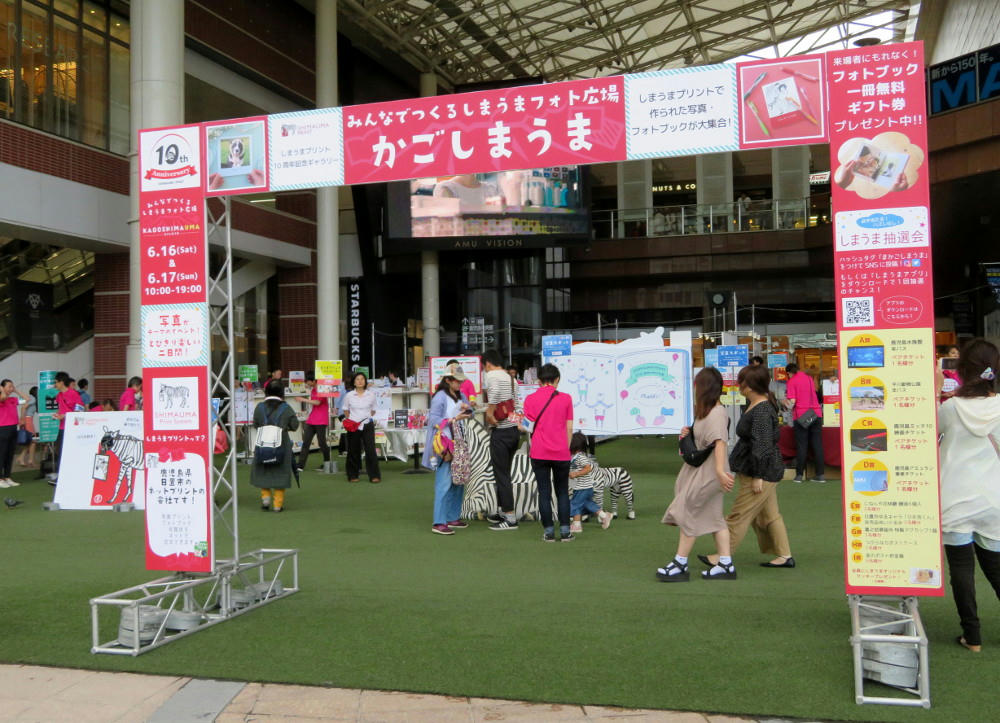
I've had a fair amount of translation clean-up work lately, which has been eating away at my free time. The only times I was able to get out on Saturday were when I went grocery shopping, and then when I had one lesson at the school at 7 PM. Fortunately, there didn't seem to be much in the way of events this weekend, so I didn't miss anything on Saturday. But, I wasn't able to get out of the apartment on Sunday until close to 4:30 PM, and by that point what was going on at Amu Plaza was almost over.
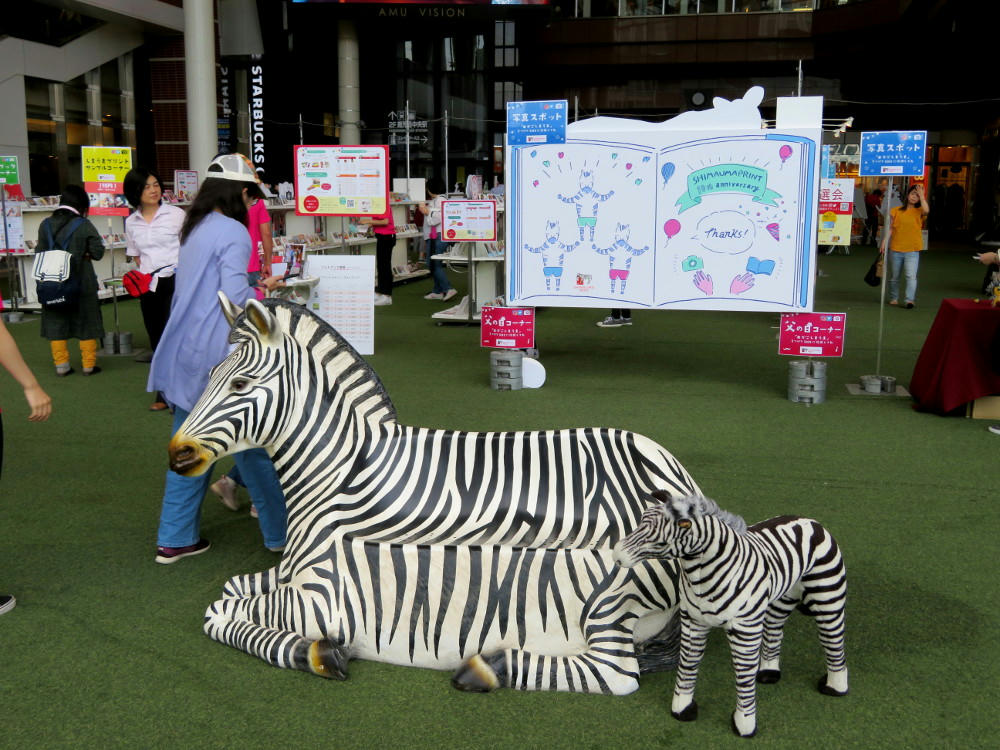
What was going on was called "Kagoshima-uma," which is a wordplay on "Kagoshima" and "shimauma." Kagoshima is the city I'm in. "Shima" is "stripe" and "uma" is "horse." "Shima-uma" is "zebra." Shimauma Printing is a company that makes photo albums and books, and the event was an opportunity for people to have their favorite photos printed out, or to take Father's Day photos and have those printed.

There were a LOT of "photo themes" (album books, I guess, I didn't look that closely) to pick from. I didn't see prices marked anywhere, so I don't know what the company was charging for this service.
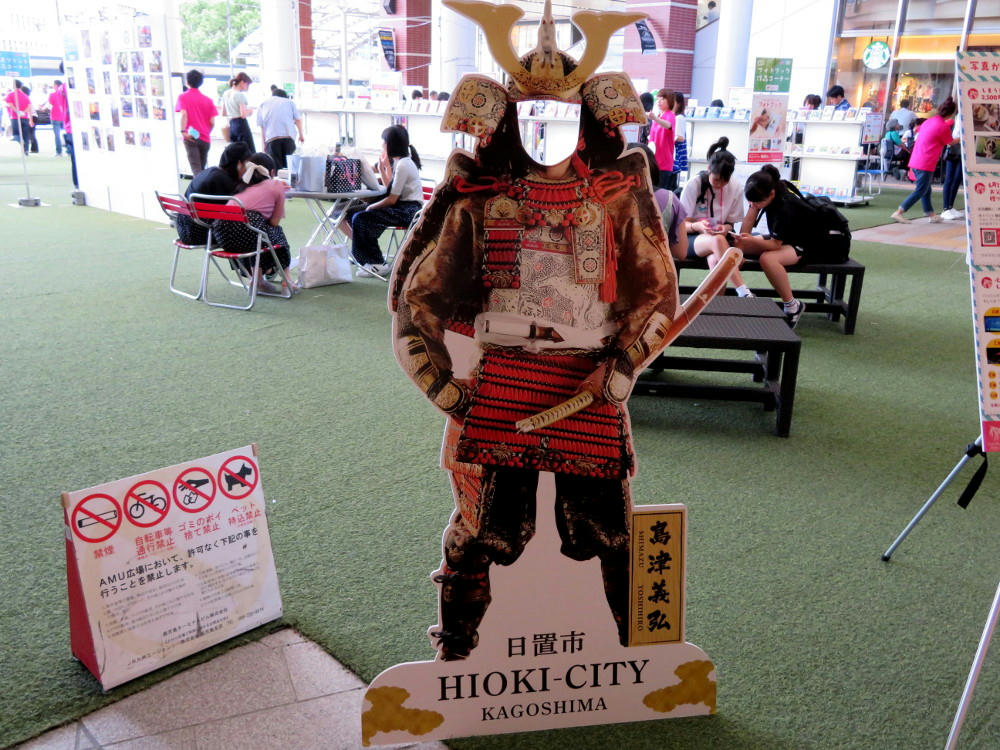
I finally figured out that the armored guy at the barrier-free event a few weeks ago was advertising Hioki City, which is about 10 miles west of Kagoshima.
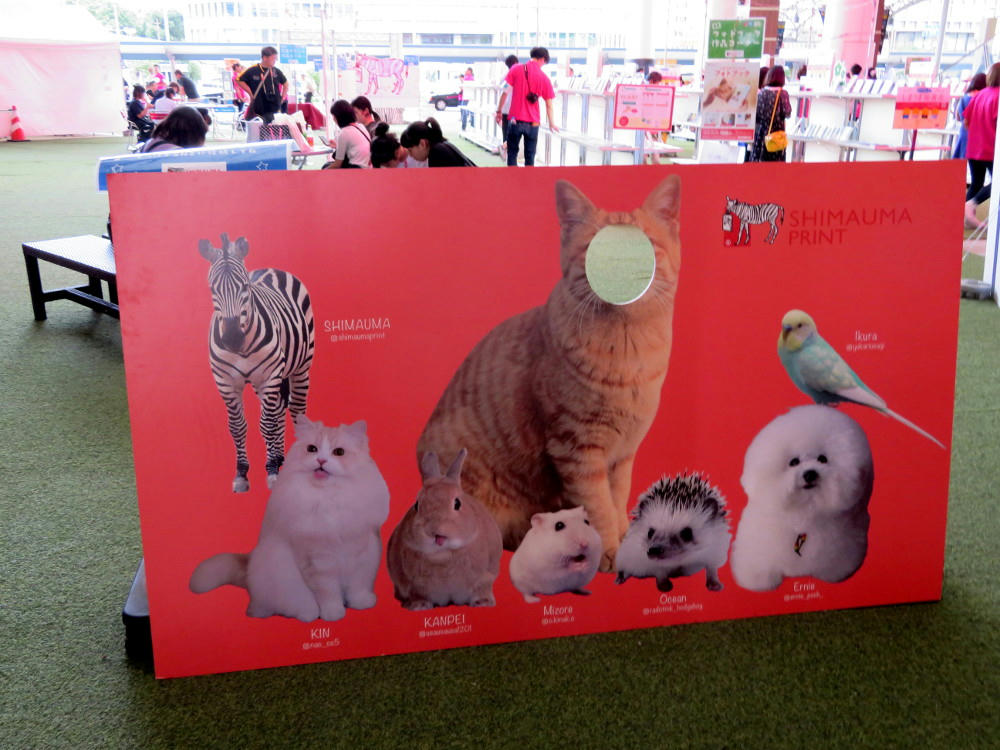
Shimauma Print loves all kinds of pets, but you only get to be a cat.
I have a color ink jet printer and glossy paper, so it's not like I really need a special service to make prints for me...
Saturday, June 16, 2018
Capsule Ball Toy Squishy Mercury

I'd been wanted to get something from the capsule dispensers again, but there hasn't been much I've want to pay the money for (the better toys are between 300 and 500 yen ($3-$5 USD). Some of the historical Japanese treasures stuff, like masks, shrine markers, etc. are nice, but they go for 500 yen, and there's not much you can do with them after you get them. But, I did settle on one of the "squishy planet balls" toys for 200 yen.
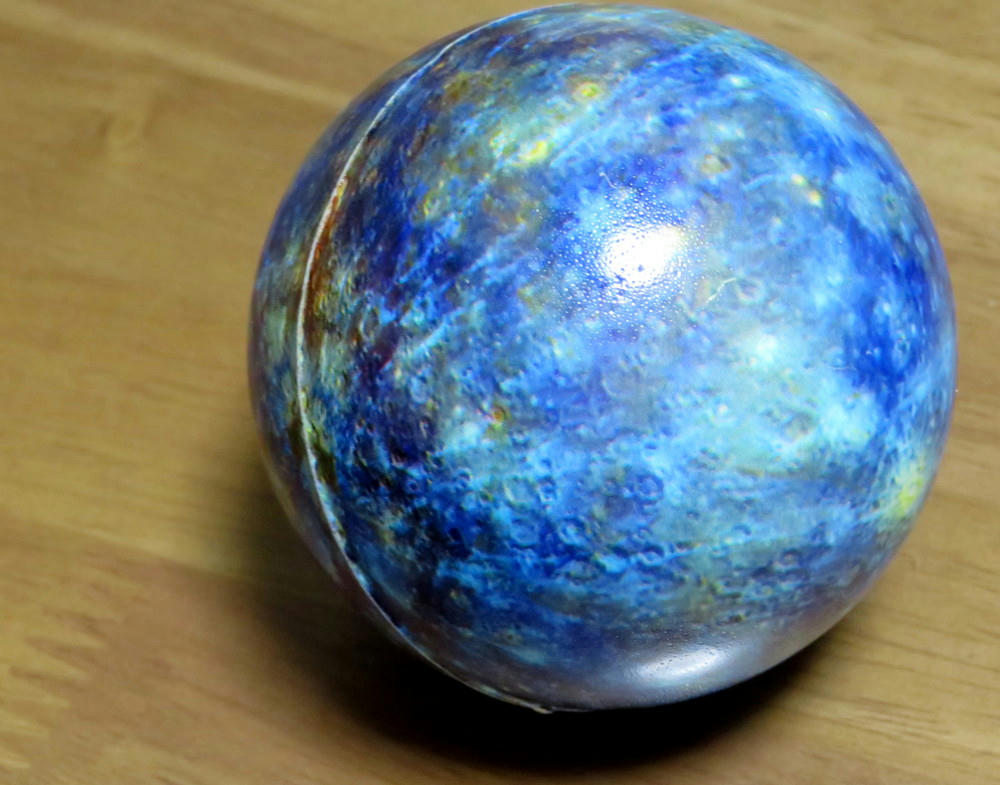
These are soft rubber balls, about 2" in diameter, that again serve as their own shipping containers. 10 in the set (all eight planets, plus the moon and the sun). I got Mercury. Fun for throwing at trees.
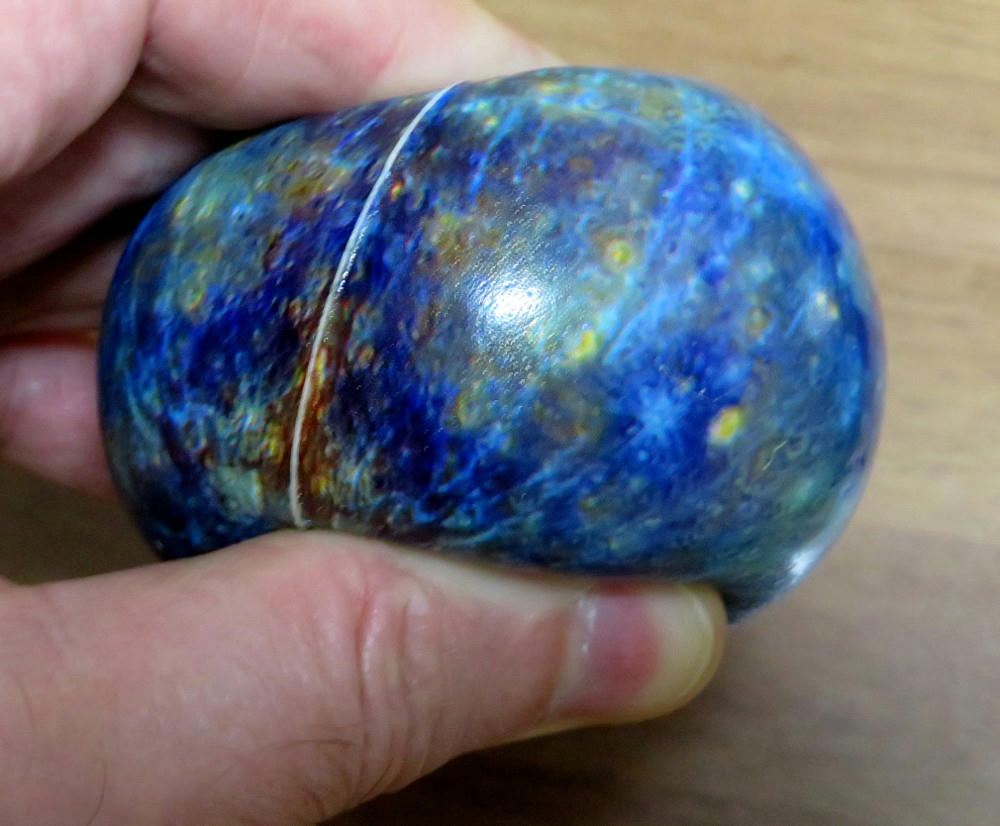
Friday, June 15, 2018
Butt Grows
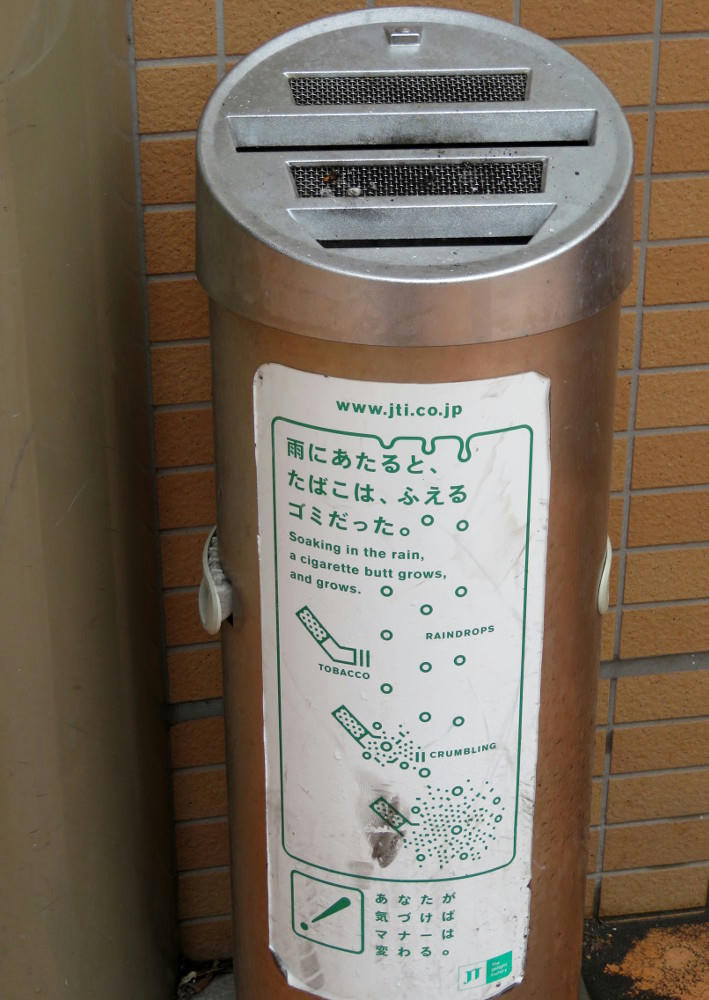
There's this line of "good manners guidelines" signs on outdoor ashtray stands around the city. They use rather pointed humor to try to get smokers to think a little more when they smoke. Hosted by Japan Tobacco, Inc.
This one reads, "Soaking in the rain, a cigarette butt grows, and grows." "Raindrops" "Tobacco" "Crumbling"
Thursday, June 14, 2018
Loop Shoes Chalk - Face
Wednesday, June 13, 2018
Mirai no Mirai poster
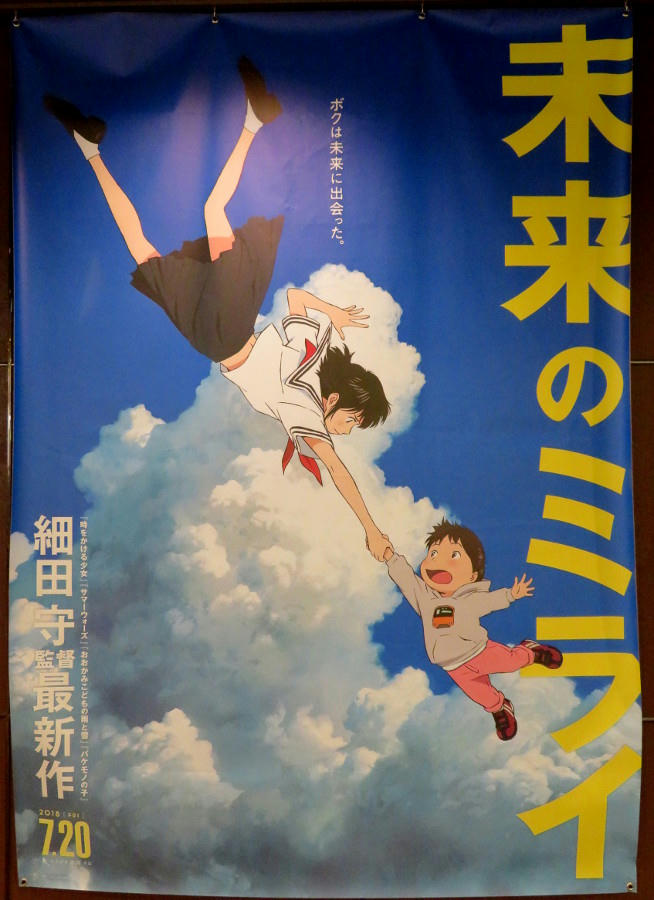
Mirai of the Future. Ad poster for new movie, about a young boy that finds a garden where he can travel through time to meet family members from different eras, guided by his younger sister, Mirai-chan. (Note that "mirai" = "future.")
Tuesday, June 12, 2018
Monday, June 11, 2018
Car Carrier
Sunday, June 10, 2018
Lock Day
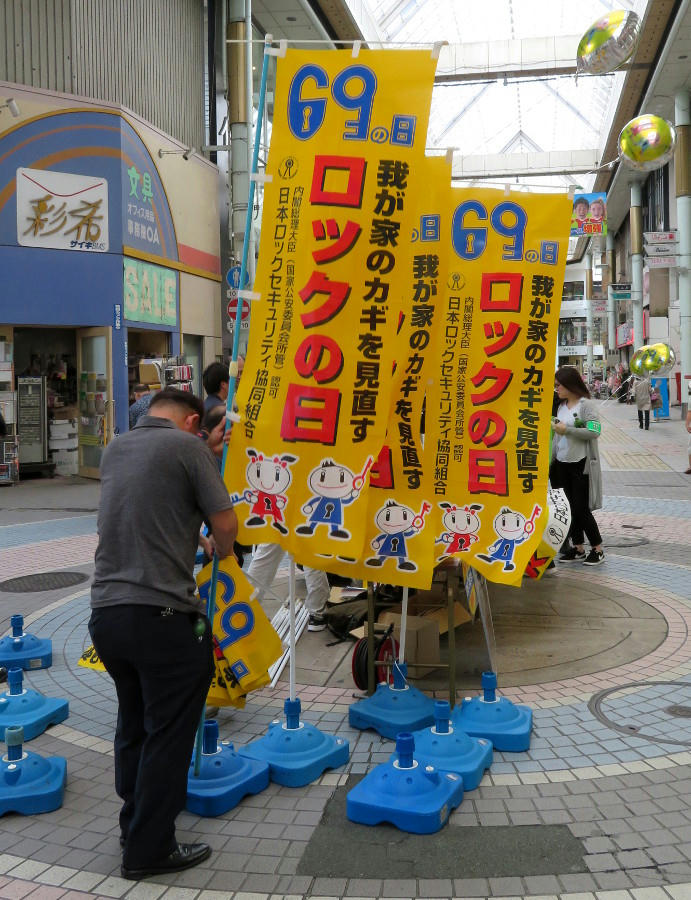
The Japanese have a practice of using the different pronunciations of the kanji for numbers to form other words. The classic example is 2 and 9 ("ni" and "kyu" or "kuu"), which normally would be ni juu kyu nichi (the 29th day of the month), but which becomes niku ("meat"). Some fastfood restaurants have "niku no hi" (meat days), where they serve burgers with extra patties on the 29th of the month at a slight discount.
Apparently, someone thought that "lock," pronounced as "roku" could be turned into "Roku no Hi" (6-9 day) on June 9th. I've never seen this done before, but as I was walking through Tenmonkan on Saturday, the 9th, on my way to the English school, I encountered this small display of lock and key systems for houses and apartment buildings, and banners announcing "roku no hi" (Lock Day).
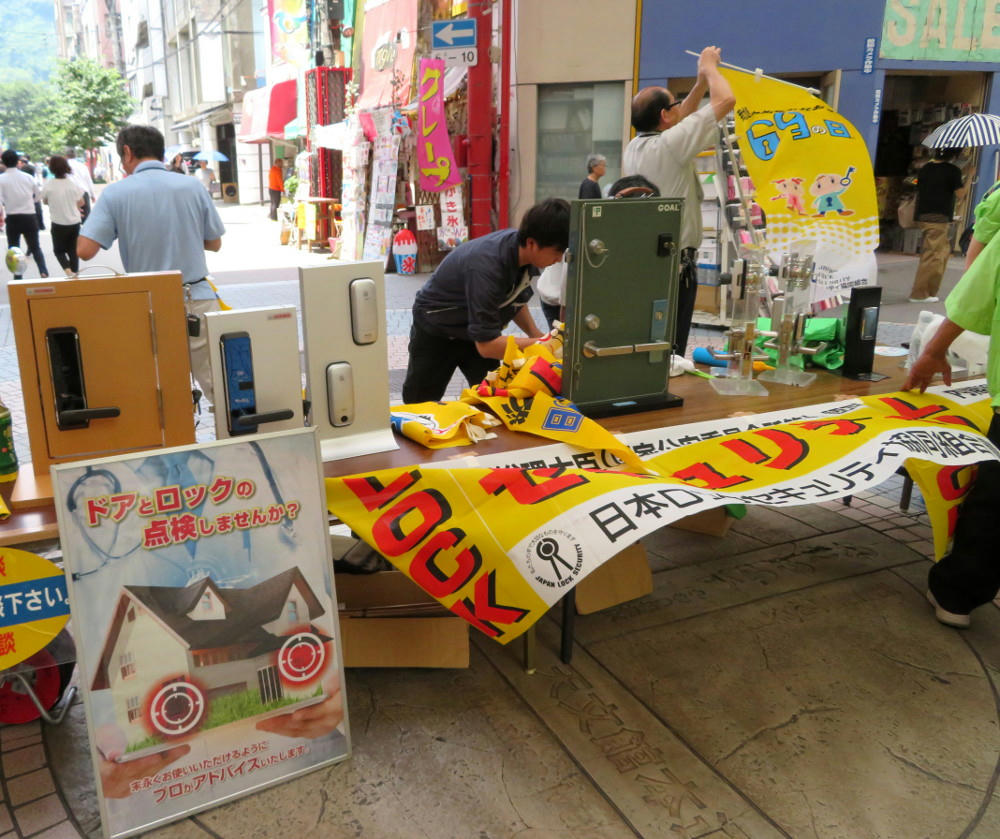
I arrived right at 1:45 PM, and they were already starting to tear down the banners and put stuff into boxes. So, I'm really not sure who the intended audience was for this. It's another one of those "blink and you miss it" things.
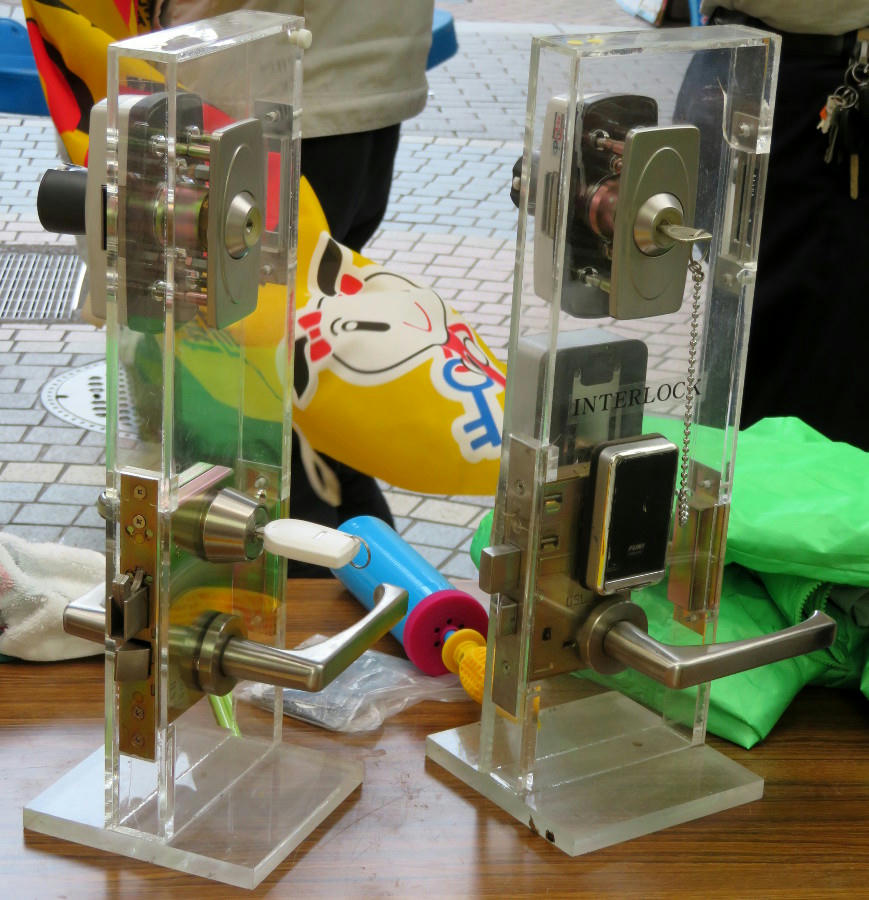
They only had a few sample systems out to look at, but at least some of them were in see-through cases, so you could watch how they work as you played with the keys (a couple were electronic, and one was a double-lock combination that needed two simultaneous keys to operate).
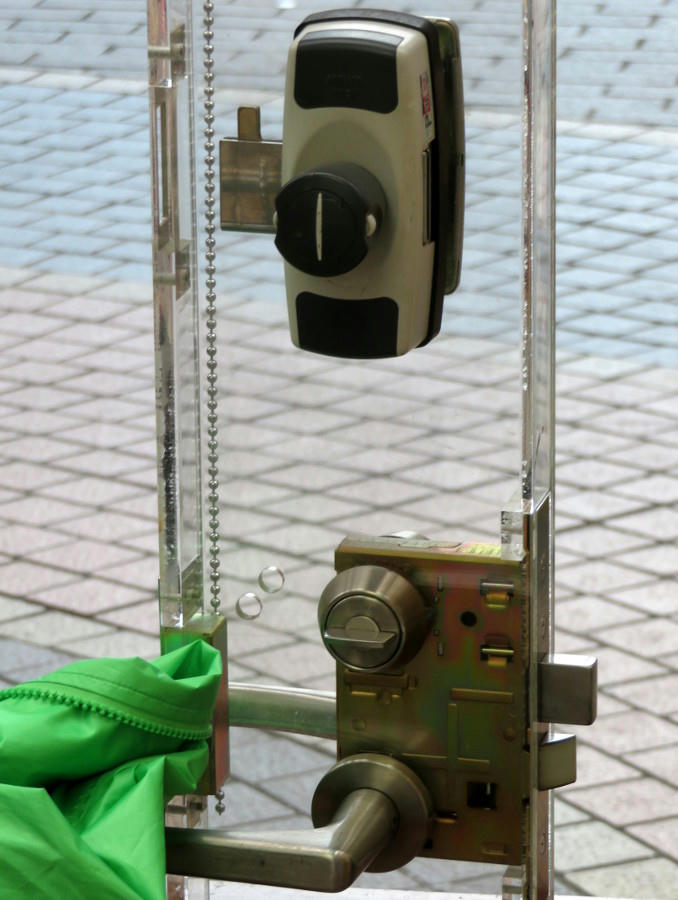
I would have liked to have had more time to look at them more closely, but I needed to get to the school in 5 minutes. And, as I say, they were already doing tear down. The main thing, though, is that the symbolism on their banners for "6" and "9" seemed to have completely escaped everyone there...
Otherwise, nothing of any note this past weekend. Apparently, we're entering rainy season. In previous years, this meant 2-3 weeks of non-stop drizzle. This year, it's sporadic real rain and overcast skies. Promises to be a miserable (hot and humid, but mostly humid) summer.
Saturday, June 9, 2018
Gakkou Kaidan, vol. 1 comments
(Image from amazon.co.jp, used for review purposes only.)
Gakkou Kaidan (School Tales of Horror) by Yousuke Takahashi, Grade A
Yousuke is probably one of Japan's most prolific horror manga artists, but he's not as well-known outside of Japan as Junji Ito. In 1995, Yuusuke began running Gakkou Kaidan in Weekly Shonan Champion, for a collected 15 volumes total. Before that, he had Mugen Shinshi, which started in 1982, in Comic Ryu. I first encountered Takahashi when I found a used copy of Mugen Shinshi, vol. 1, at Mandarake in Akihabara around 2010. Shinshi is more of a light-hearted detective adventure set in the Showa Era (1926-1989), in kind of a Doc Savage vein, but still heavily laced with the macabre. It was a really fun little book, but I wasn't able to get the next volume used, and I ended up moving to Kagoshima, which doesn't have a Mandarake outlet.
However, we do have Maruzen books, and they have "wide" (smaller height and width, but 2-3 times more pages per volume) collections of both series, new. They're more expensive than normal, at 700 yen for Gakkou, and 950 yen for Shinshi, which is why I've held off on buying them. But, nothing really interesting has been coming out for new releases in the last month or so, and I was becoming more curious about what Gakkou was like. Eventually, I broke down and got volume 1, and here we are.
The short description is that Gakkou Kaidan, is a series of short (8-10 pages) horror stories set in one high school. Manga Updates says that they're along the lines of R. L. Stine, but I haven't read Goosebumps, and I can't make a comparison. I do think the artwork is a lot grosser than anything Stine would feel comfortable employing. And, Japanese horror tends to be more atmospheric and creepy, where American horror resorts more to shock value. So, I'm not sure Stine is all that similar.
Going into a bit more detail, Hida Yamagishi is a semi-girlish looking teenager attending a rather typical high school in a more-or-less rural community. In every single story, Hida and/or one or more of his classmates get sucked into some kind of bizarre situation that more often than not results in at least one gruesome death, if not Hida's, then that of someone he knows. There are strong Twilight Zone and Night Gallery vibes to these tales, and just as with TV sitcoms, everything is back to normal at the beginning of the next chapter. In volume 1 (36 chapters, 408 pages), Hida himself dies at least 10 times, making him more of a recurring actor in an ongoing episodic TV series, than the hero or main lead of an unfolding storyline.
The character designs are kind of old-school, looking more like they come from the 60's or 70's, but the backgrounds are incredibly detailed and well-drawn. The stories flow fast, and are really hard to tell where they're going in the middle. The "twist shock" endings are predictable if you've watched enough horror, but the drawings of the "victims" of whatever evil is going on are really, really elaborate, and can still punch you in the gut.
Just for examples, we have a boy that suddenly walks into an invisible wall surrounding his neighborhood, preventing him from going to school. Yamagishi visits him to find out what's happening, and the boy says that the walls keep slowly closing in on him. This goes on for several days, until, as Yamagishi is talking to him, the walls squeeze down to a small cube, crushing the boy, and ultimately he disappears altogether. Immediately after, as Yamagishi is walking home, he walks into an invisible wall. In another chapter, a different student was out in the woods, when a leech fell on the back of his neck. The boy passed out, and when he recovered, he found himself standing over what looked like his dessicated corpse. He dressed himself in the corpse's clothes and pushed the husk into a swamp. He visits Yamagishi to say that "he" really isn't "himself". Yamagishi goes to the kitchen to get his classmate something to drink to calm down, but when he gets back, the boy is gone and his clothes are lying on the floor. Yamagishi turns around to call to his mother, and notices a leech on the back of his neck. When his mother comes to his room a little later, a naked Yamagishi is standing over his dessicated corpse. The leech copy tells his mother "'I''m not 'me'." Finally, in a more feel-good story, Yamagishi goes out to the sea, and discovers a fishperson. It turns into a beautiful girl, and he gives her his shirt to cover herself with until they can get to a store to do some shopping. It's a hot day, and as they're waiting for a bus, the girl wilts and turns back into a fish. Before she can die, Yamagishi gets her back into the ocean. Eventually, he notices that his shirt is missing. The scene switches to show the mermaid girl in half-human form happily swimming off in a school shirt.
Summary: Takahashi is primarily a horror artist, but his stories rely more on pacing and slow reveals, than on shock tactics. The artwork is good, and the stories are told well. It may be better to read them in short bursts, rather than 10-12 chapters in a row like I did, but I did find these to be an easy read in Japanese. Recommended if you think Junji Ito is a little too extreme.
Friday, June 8, 2018
Small Adventure 63
There's kind of a dichotomy about polite, helpful Japanese behavior. On the one hand, the Japanese have a reputation for going out of their way to assist others. On the other, there's this claim that polite behavior on the trains consists of no talking with others because it may "disturb someone else" in one form or another (combined with the cramming of people into sardine cars, no matter how it may inconvenience everyone else already in the train. That is, it's an "every man for themselves environment."
I was riding the tram one morning, and we'd stopped at a transfer platform. The tram I was on was going to continue south to the end of the line at Taniyama. The other tram line goes west and then north on its way to the main Chuo train station. The driver was waiting for the light to change when a small, very old man with vision and knee problems tried to haul himself up the steps into the tram. He asked "Is this the tram to Chuo station?" No one else reacted, no one looked up, no one showed any intention of helping the guy or answering his question. The entrance into the tram was towards the back, so the driver was unable to hear the question.
Rather than wait as the guy struggled to get into what was obviously the wrong tram, I loudly answered "Chigaimasu" (this is the wrong tram). He immediately backed out of the car and left. Now, I've 10 of the 20 people in the car staring at me like I'm the most evil thing on the planet for having the gall to invade their comfort zones by talking too loud. I just smiled and stared back until they crawled into their shells again.
Thursday, June 7, 2018
Nomi Tori Zamurai Poster
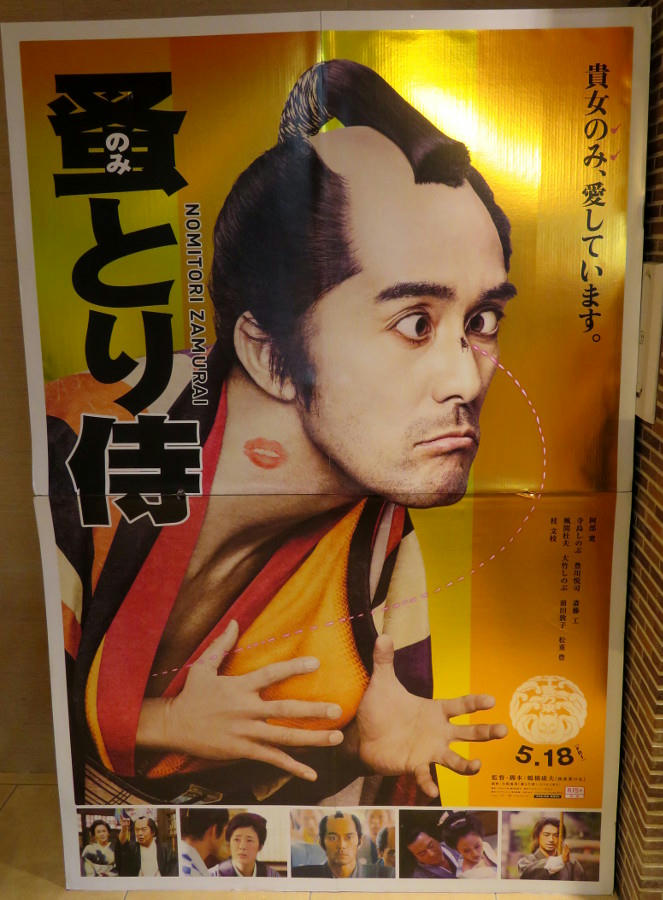
Flea Samurai. A new movie. You can check out the synopsis if you like. I'm just amused at the way the art department set up the ad poster to parody one of the most famous kabuki ukiyo-e woodblock prints.

The joke is that the character is a samurai that angered his daimyo, who then tasked him to catch fleas off of cats.
Wednesday, June 6, 2018
Kagoshima 150th Meiji Restoration Walking Ad
Tuesday, June 5, 2018
Planning Ahead...
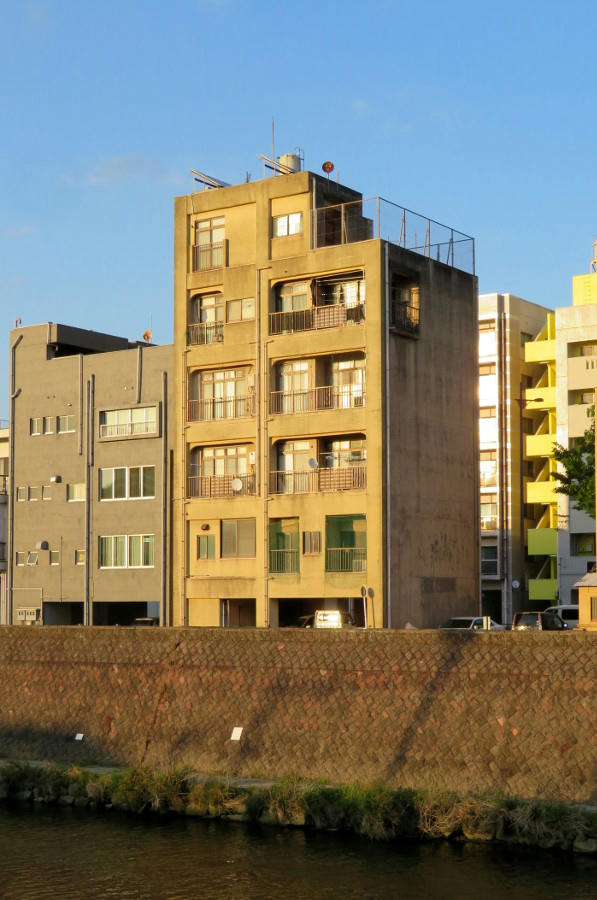
There are things where, when you see them, you know that there'd been a decision in the past that must have made sense at the time, but now you're just left scratching your head. Case in point, an apartment building where only the top floor has a view of the river downstream. There must have been another building next door when this one was built, and only the top floor had cleared its neighbor's roof. Maybe.
Monday, June 4, 2018
Gambarre Kagoshima
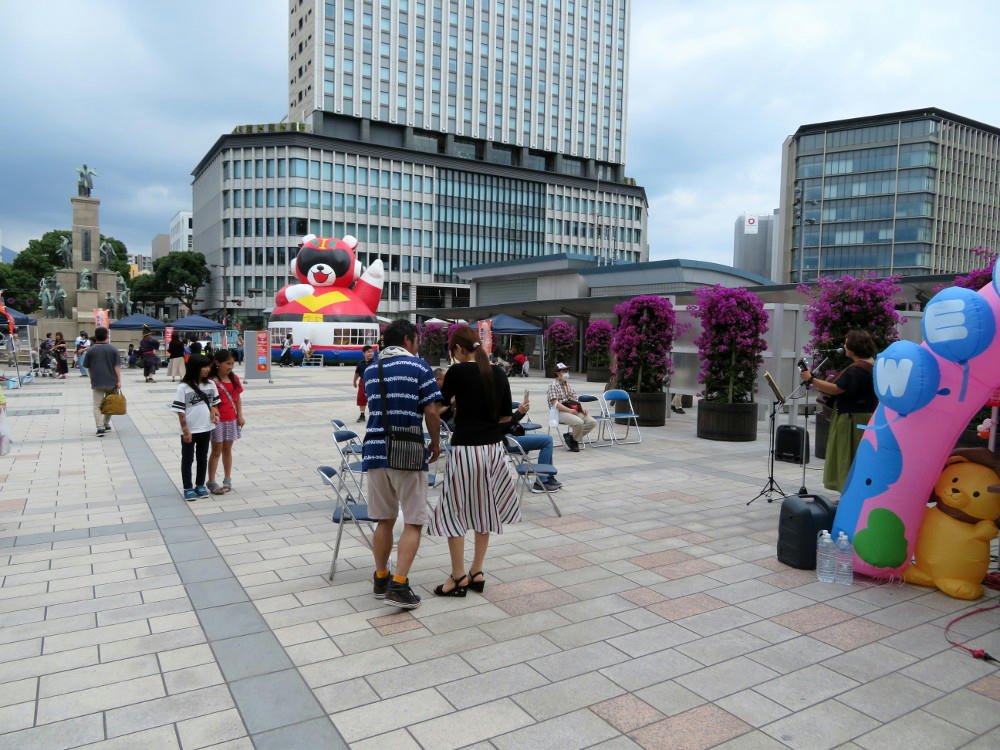
I'd seen a little advertising around Amu Plaza a few days earlier, so I knew something was going to be happening on Sunday (1-day event). Nothing else was going on over the weekend, so on Sunday I went up to the main train station to see what was there. Turned out that they had upwards of 6 music stages in and around the area, but I only found 3 of them. One was in the big open space in front of the station, where they had a few games set up for the kids, plus the jump room. The event was sponsored by Barrier-Free Kagoshima, an NPO to get businesses to make things more wheelchair accessible.
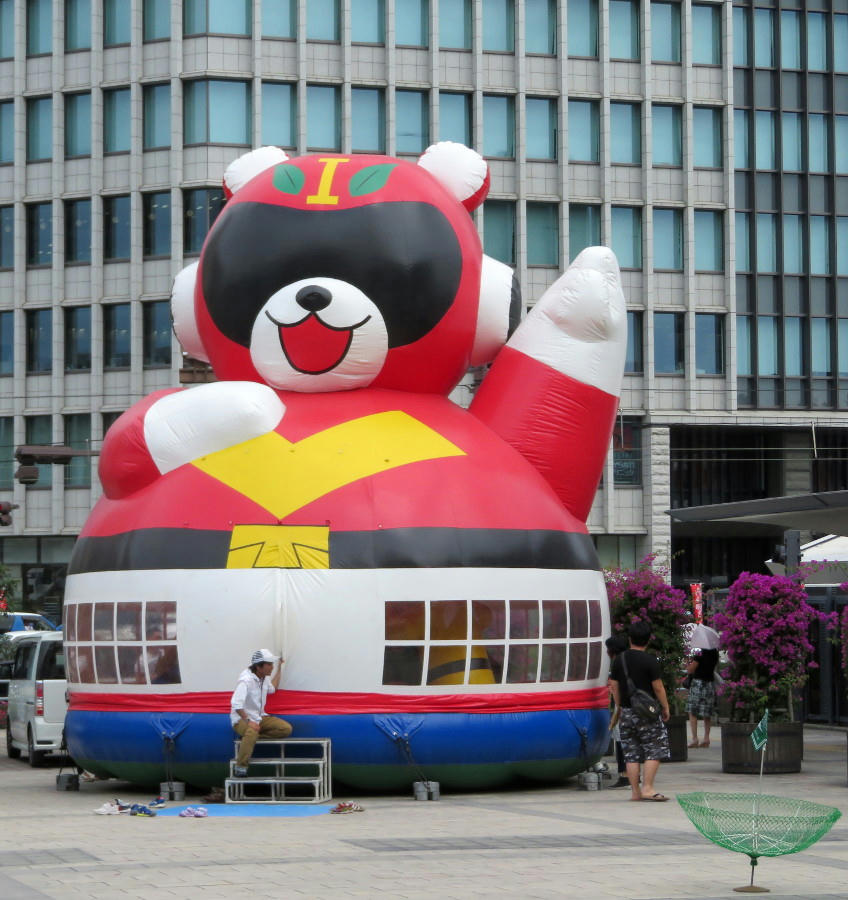
They had a similar event a year or two ago, and one of the keyboard players was in a wheelchair. The stage didn't have a ramp, and crew workers needed to hand lift her up and down from the stage. I think the irony was lost on the organizers. I didn't see her playing this time, and no one else had physical disabilities that I noticed.
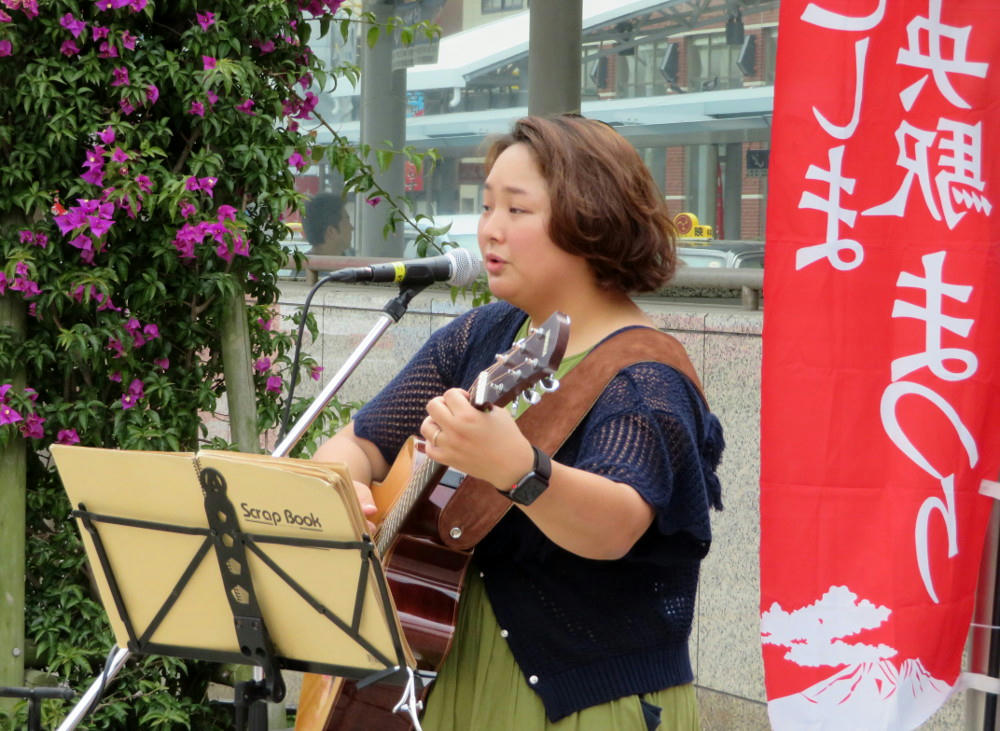
Most of the music was traditional folk songs, which was alright, but didn't attract much in the way of crowds. I didn't recognize the names of most of the people performing. I think the above woman is Konomi Arigawa.
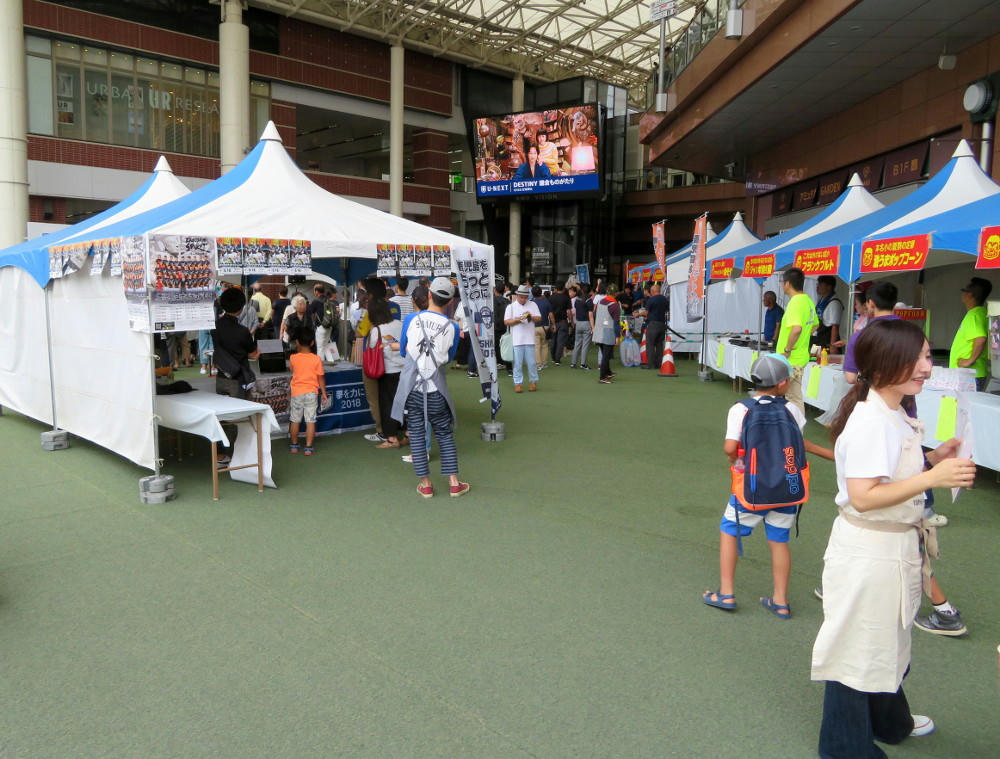
Amu Plaza had a couple food stalls set up, but mostly it was souvenir tables, and advertizing for the Rebnise basketball team.
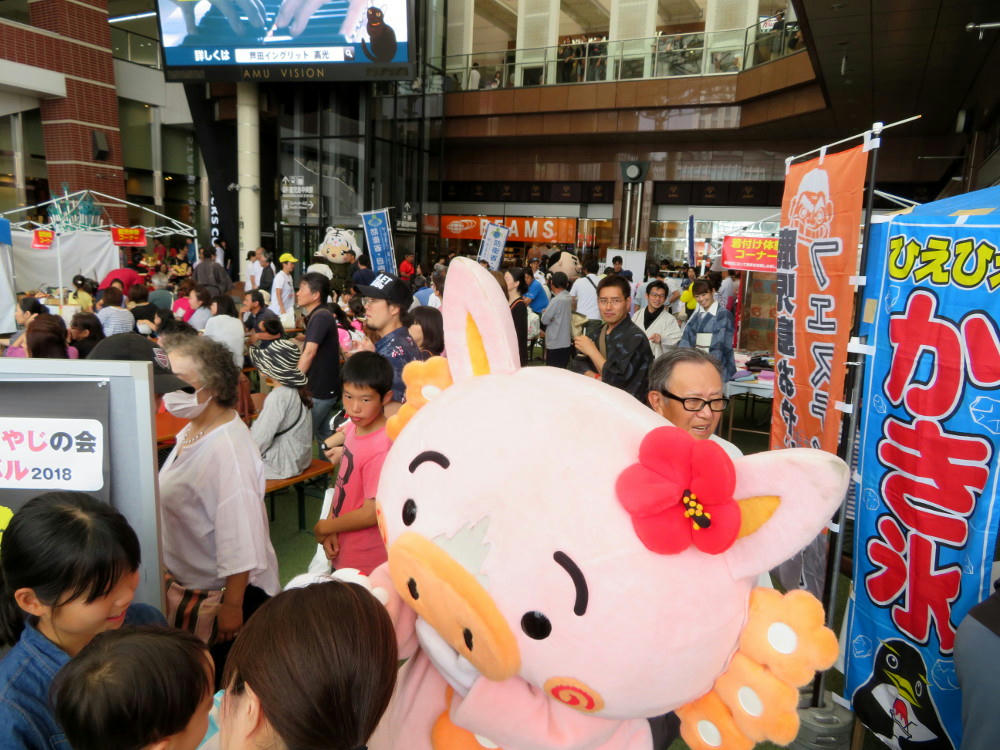
They also had a few foamhead mascots working the crowds. The main stage events were hula dancers from one or two of the local dance schools.
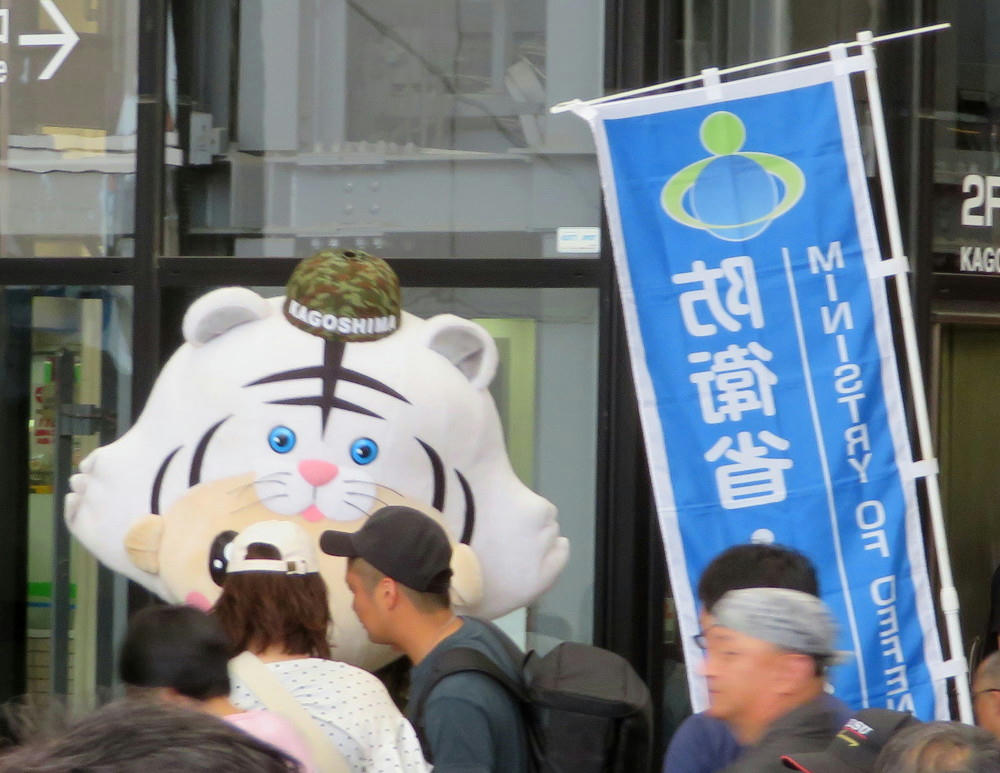
A foamhead for the Ministry of Defense.
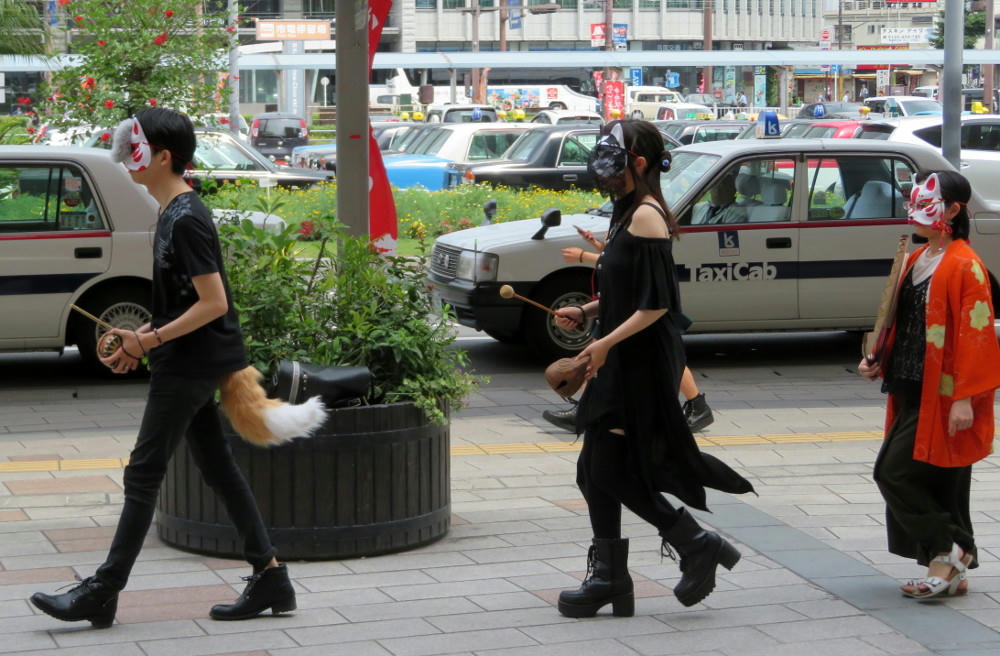
The woman who paints kitsune (fox) masks was also out here somewhere, and her husband led the ever-growing kitsune parade through the plaza at one point.
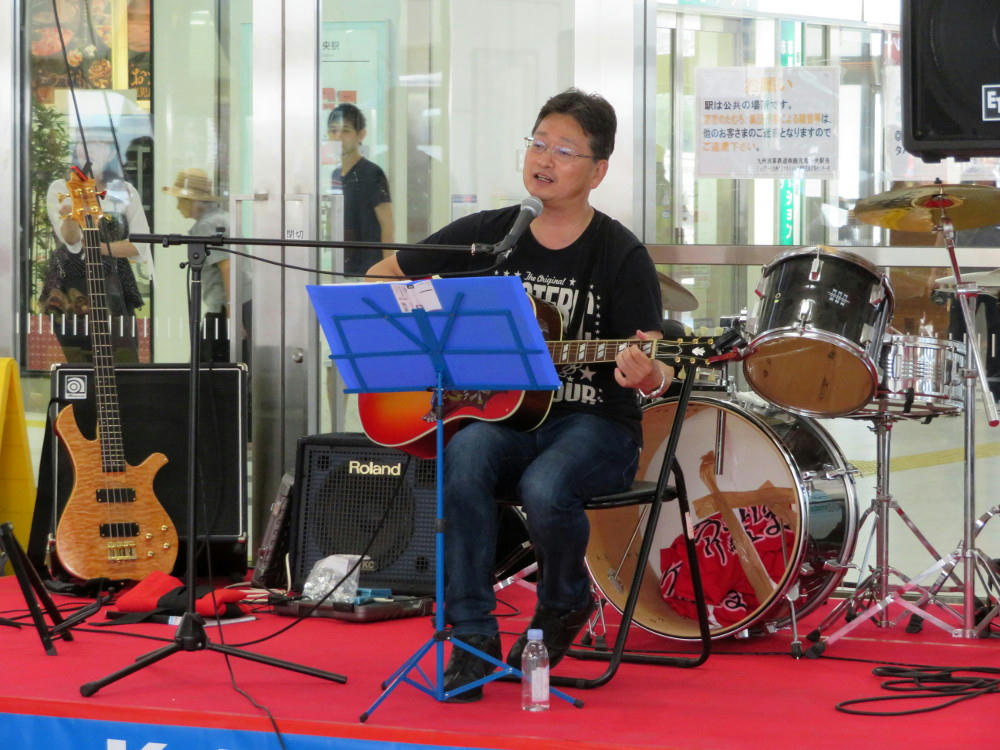
The third stage that I found was at the west side of the station. Each stage had about 10 performers. This guy is another traditional folk singer, named Kouto. While I had made kind of a big deal in a previous post about wanting to talk to more performers now, there weren't any real opportunities this time, in part because they were usually surrounded by friends and family when not playing. That, and they weren't playing my kind of music.
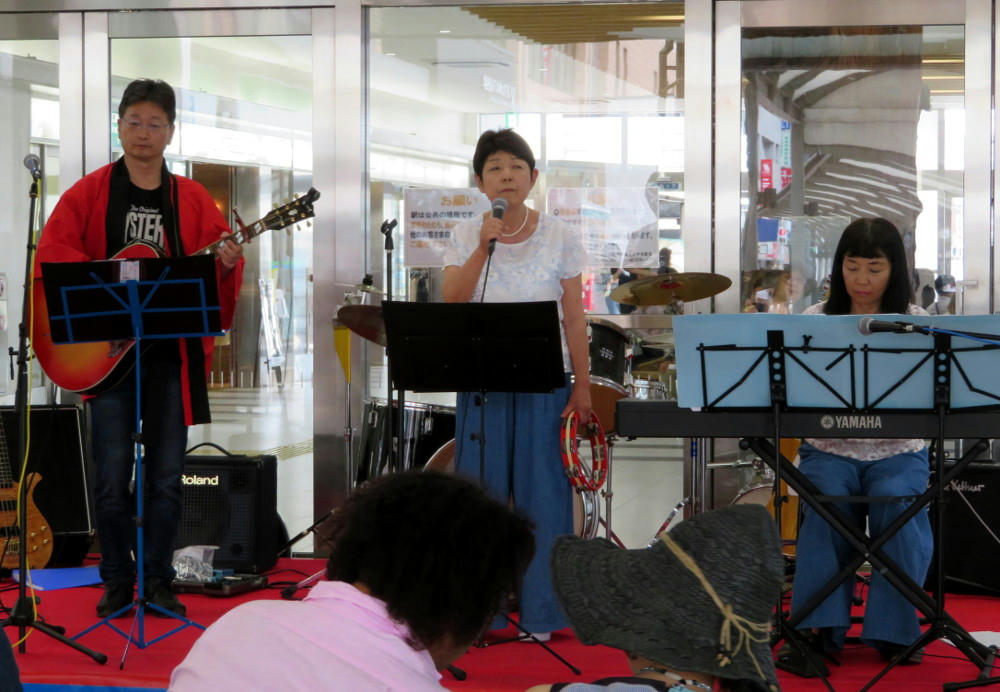
The Kayo-chan Band.
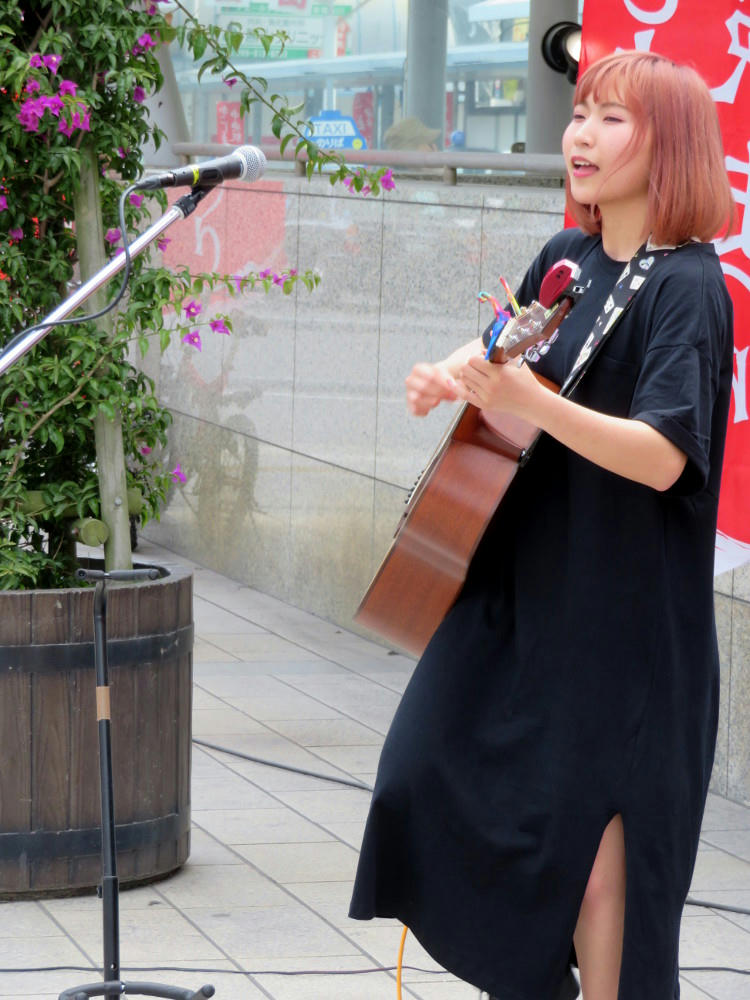
Of all the players, there was one that was the most photogenic. Unfortunately, she played really screechy protest songs that were hard to listen to. She did have one of the larger audiences, though, and she was definitely playing her heart out.


She very conveniently had her name spelled out for anyone that wanted to book her - Maka Narita. Her sign also advertised her March 12th release of her first CD.
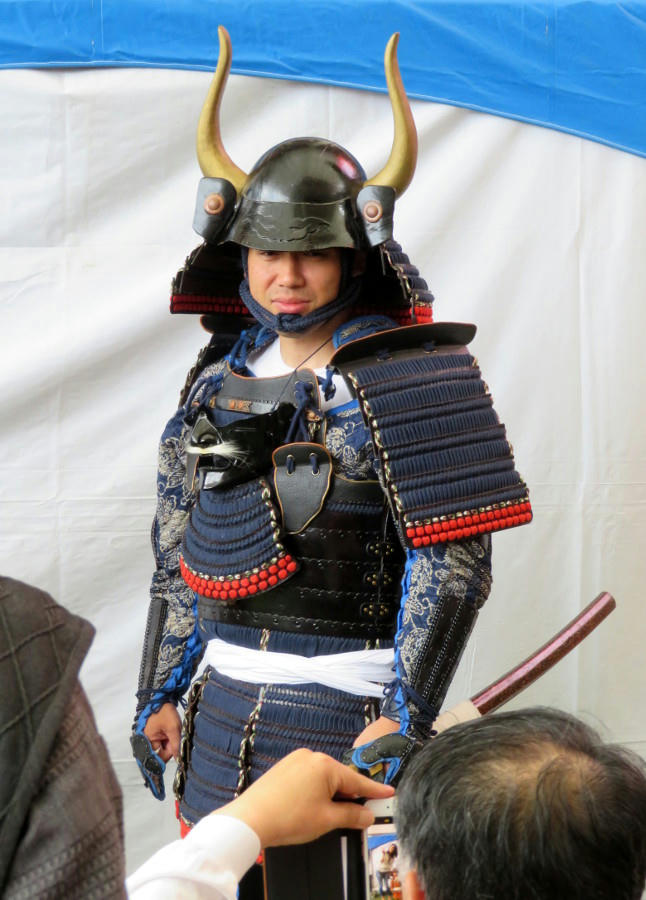
Another city mascot, but I'm not sure which one. He was posing for photos near the hula dancers.
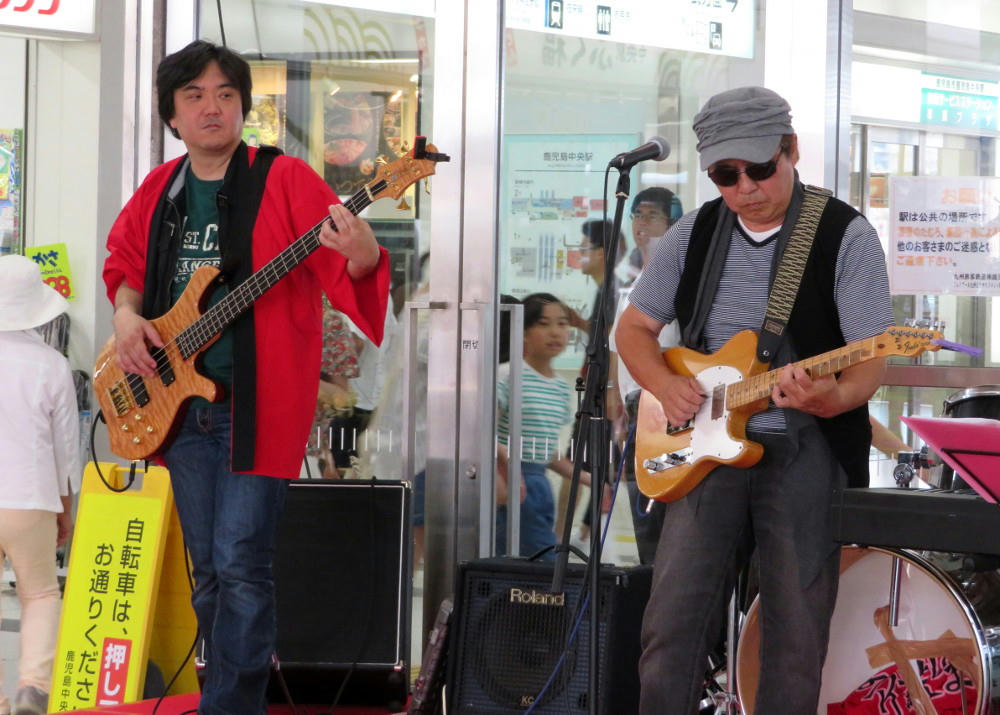
Back over at the west side, we have O-ruda-za (Olders), a folk band fronted by an old guy that didn't want people calling him old.
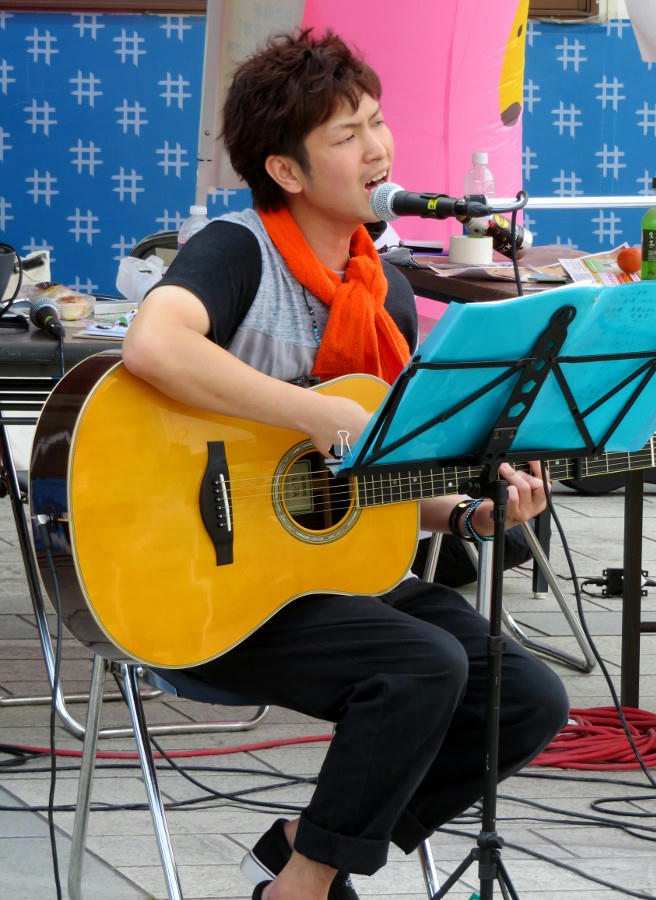
Finally, I lost track of who was playing when. I needed to do some work in the apartment, and none of the music was really grabbing me at this point. It was nice to have the event here to listen to it all, so that part was ok. I just wish that at least some of the music was harder rock, or that they were anyone I knew.
At least, the weather was nice for a while.
Subscribe to:
Posts (Atom)

